Giro d'Italia 2024 route: Stelvio removed due to 'risk of avalanches'
The Italian Grand Tour takes place 4-26 May, building up to tough Dolomites crescendo
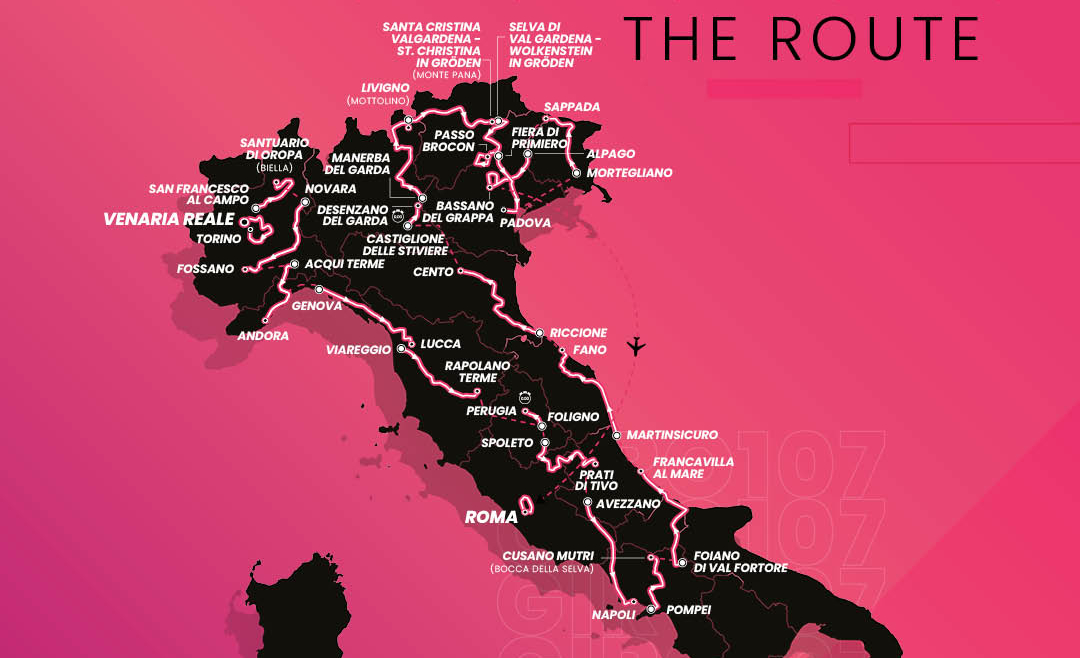
Tom Thewlis
The iconic Passo dello Stelvio will no longer feature in the 2024 Giro d'Italia route.
The climb was planned to star in stage 16, marking the race's Cima Coppi – its highest point – but was removed by the organisers mid-race due to the "risk of avalanches".
"The recent snowfalls on the Stelvio Pass, followed by the rise of the temperatures, are increasing the risk of avalanches," a statement read.
The new Cima Coppi is the Umbrailpass, at 2,489m, which features early on stage 16.
Also included in this year's route are gravel sectors and a tough new climb.
The 107th edition of the Italian Grand Tour began in Piemonte on 4 May and is planned to finish in Rome three weeks later.
Below is a detailed overview of the route, written at the time of the announcement, followed by a stage-by-stage analysis, which is being updated throughout the race.
Get The Leadout Newsletter
The latest race content, interviews, features, reviews and expert buying guides, direct to your inbox!
The Giro d'Italia will open with a Grande Partenza in Turin, before a category-one summit finish on day two in Biella.
The 2024 parcours is a challenging one, including two individual time trials, six mountain finishes and a final-week crescendo in the Dolomites.
After the Grande Partenza, stage three will be the first of a trio favouring the fastmen. On day six, the flat tarmac will then give way to gravel tracks, when sectors of Strade Bianche's famous sterrato will take over the race route.
Stage seven will offer the first of two individual time trials. Finishing on an ascent in Perugia, this initial race against the clock stretches out 37.2km from Foligno and promises to force gaps between the GC favourites.
The first week will then close with two challenging stages: a mountains test on day eight, finishing atop the Prati di Tivo, followed by a winding course into Napoli on stage nine.
After a rest day, the second week will leave the famous archeological site of Pompeii and head towards the country's Adriatic coast. Stages 11, 12 and 13 come with their own complications, but are all expected to finish in sprints.
A second individual time trial comes on day 14, 31km in length, and held on a flat course, finishing on the shores of Lake Garda.
Stage 15, the race's longest at 220km, is also one of its most difficult. Leaving Lake Garda, the peloton will head into the Alps, via Switzerland, and finish at altitude on a new climb in Livigno - the Mottolino - whose summit is yet to be laid with asphalt.
Another rest day then follows, before the iconic Stelvio stars on stage 16, after a four-year absence. The mountain pass will come midway through the day, which again stretches out over 200km through the mountains.
Stage 17 will be considerably shorter, at 154km, but just as tough, finishing with a double ascent of the Brocon Pass in the Dolomites.
After two easier days, the penultimate stage also features a double ascent, this time in the form of the Monte Grappa, before a descent to the line in the foothills.
On 26 May, the winner of the 2024 Giro d'Italia will be crowned on the streets of Rome, with a city circuit closing out the 107th edition.
Primož Roglič (Jumbo-Visma) won the 2023 edition of the race, taking the pink jersey off Geraint Thomas's shoulders in a penultimate day individual time trial.
This year, Thomas will return to challenge for the crown once again, but will have to do battle with another Slovenian, this time coming up against Tadej Pogačar (UAE Team Emirates).
Giro d'Italia 2024 Stage Table
| Stage | Day | Start | Finish | Distance | Type |
|---|---|---|---|---|---|
| 1 | 9 May | Durrës | Tirana | 164km | Flat |
| 2 | 10 May | Tirana | Tirana | 13.7km | ITT |
| 3 | 11 May | Vlorë | Vlorë | 160km | Hilly |
| 4 | 13 May | Acqui Terme | Andora | 190km | Flat |
| 5 | 14 May | Genova | Lucca | 178km | Hilly/Flat |
| 6 | 15 May | Viareggio | Rapolano Terme | 180km | Hilly |
| 7 | 16 May | Foligno | Perugia | 40.6km | ITT |
| 8 | 17 May | Spoleto | Prati di Tivo | 152km | Mountains |
| 9 | 18 May | Avezzano | Napoli | 214km | Hilly/Flat |
| 10 | 20 May | Pompei | Cusano Mutri | 142km | Flat |
| 11 | 21 May | Foiano di Val Fortore | Francavilla Al Mare | 207km | Flat |
| 12 | 22 May | Martinsicuro | Fano | 193km | Hilly/Flat |
| 13 | 23 May | Riccione | Cento | 179km | Flat |
| 14 | 24 May | Castiglione Delle Stiviere | Desenzano Del Garda | 31.2km | ITT |
| 15 | 25 May | Manerba Del Garda | Livigno (Mottolino) | 222km | Mountains |
| 16 | 27 May | Livigno | Monte Pana | 206km | Mountains |
| 17 | 28 May | Selva di Val Gardena | Passo Brocon | 159km | Mountains |
| 18 | 29 May | Fiera di Primiero | Padova | 178km | Flat |
| 19 | 30 May | Mortegliano | Sappada | 157km | Hilly/Flat |
| 20 | 31 May | Alpago | Bassano Del Grappa | 184km | Mountains |
| 21 | 1 June | Rome | Rome | 125km | Flat |
Full route map
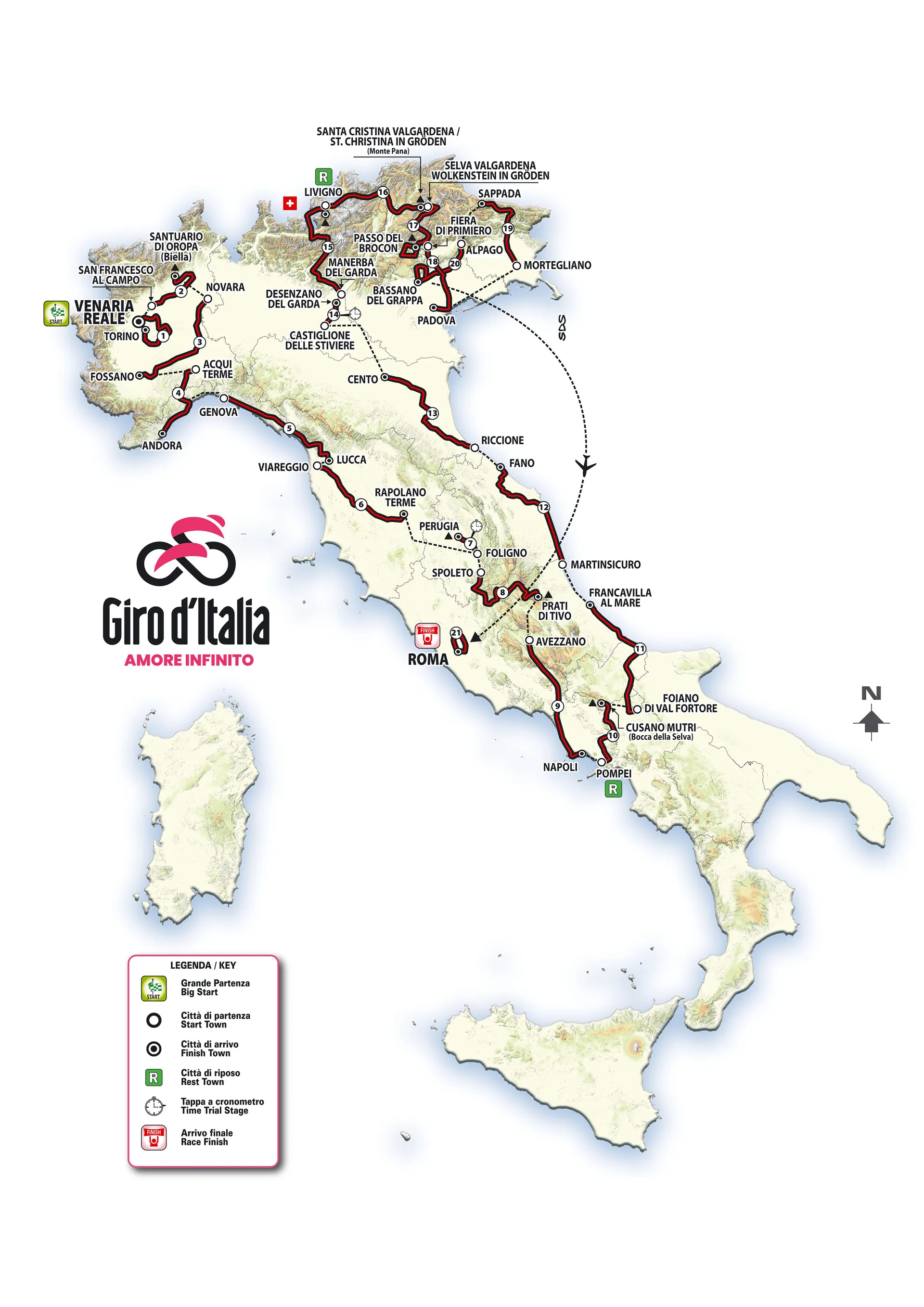
Stage by stage guide
Stage one: Saturday 4 May Venaria Reala > Torino I Hilly I 143 kilometres
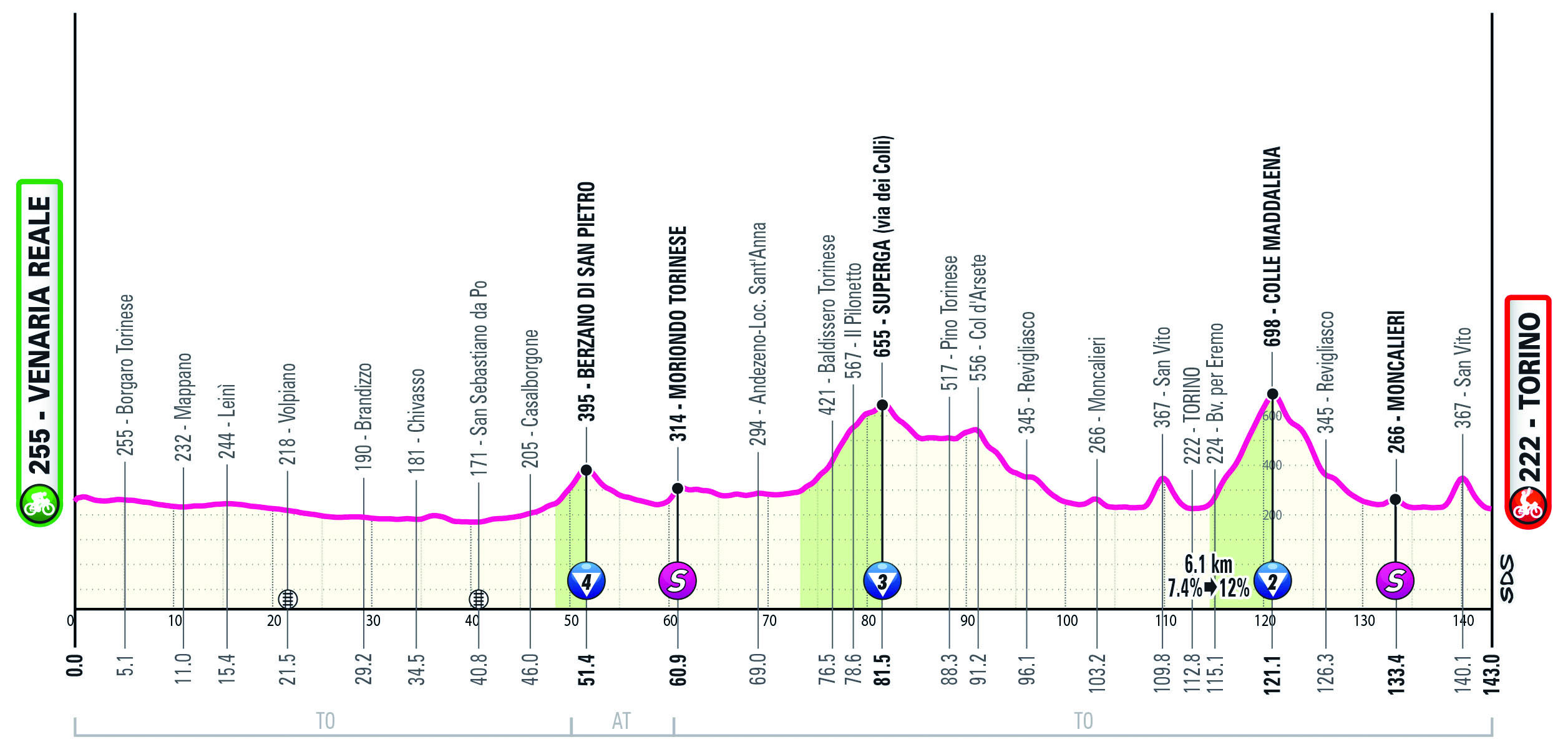
Torino hosted what will be a sombre start to the 2024 Giro d’Italia, marking the 75th anniversary of the tragic Superga air disaster in which the majority of Torino FC’s all-conquering team of its era died.
They were commemorated on the Superga climb featured halfway into the stage, while the racing kickedoff 40km later on the steep 7.4% slopes of the 6km Colle Maddalena.
Even without the late addition of an uncategorised 1.5km that rises at 10%, the Maddalena alone was hard enough to ensure a puncheur or climber rather than a sprinter donned the edition’s first pink jersey.
That puncheur was Jhonatan Narváez (Ineos Grenadiers), who outsprinted Max Schachmann (Bora-Hansgrohe) and Tadej Pogačar (UAE Team Emirates) in Turin.
Stage two: Sunday 5 May San Francesco al Campo > Santuario di Oropa (Biella) I Hilly I 161 kilometres
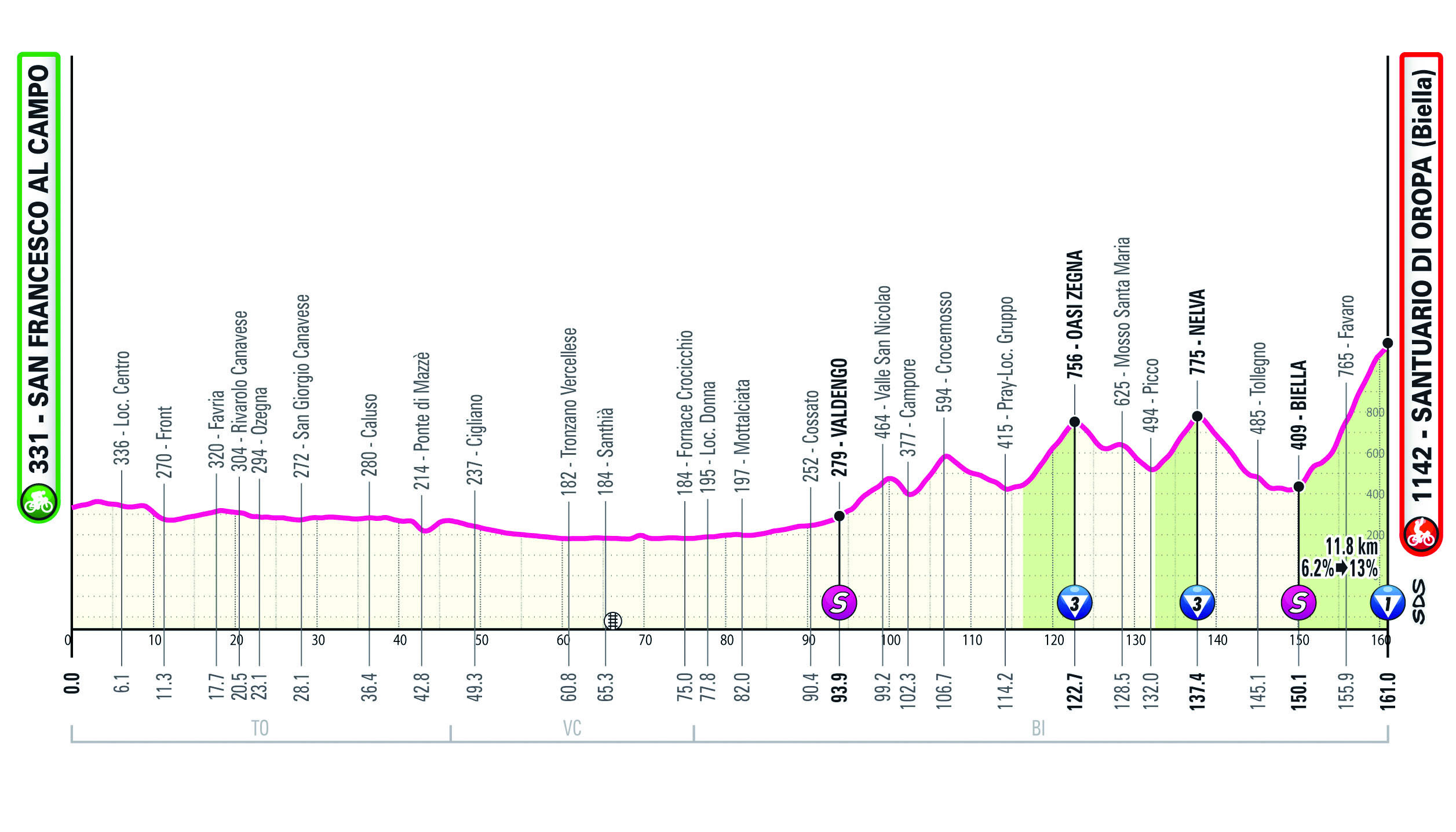
Any wannabee pink jersey winner hoping to gently ease themselves into the race was in for a rude awakening, for what was the earliest summit finish of any edition for 35 years.
That summit was Oropa, a mountain made famous when in 1999 Marco Pantani won atop it despite dropping his chain at the bottom.
With an average gradient of 6.2%, it was not necessarily one for the pure climbers, as Tom Dumoulin proved by winning here in 2017. Only 10 riders finished within a minute of Dumoulin that day, suggesting that an early but clear GC hierarchy would be formed.
Tadej Pogačar (UAE Team Emirates) recovered from a puncture and a crash to power to victory, and take the pink jersey.
Stage three: Monday 6 May Novarra > Fossano I Flat I 166 kilometres
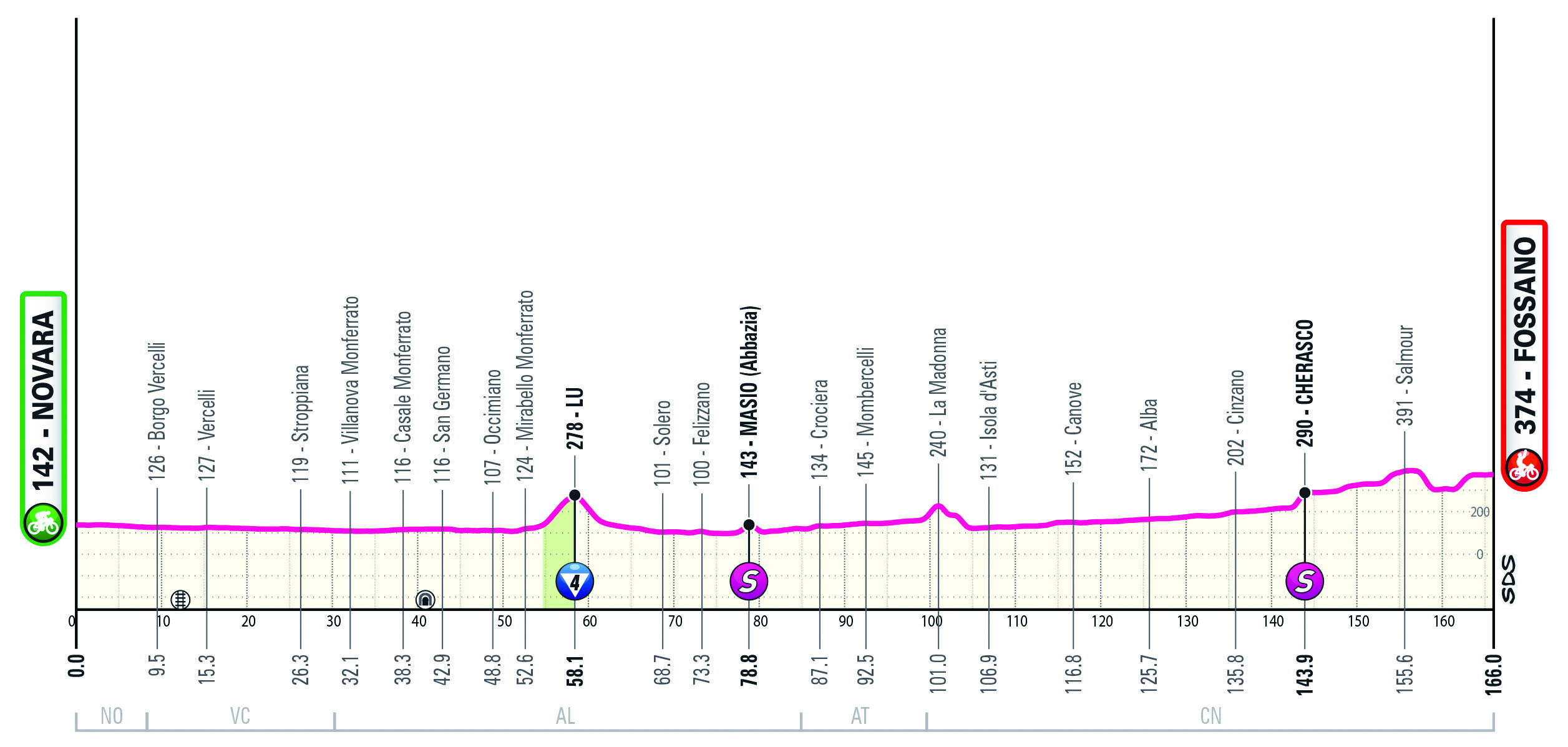
Sprinters tend to be an emotional lot, so we could only imagine how they felt about having to drag themselves up a mountaintop finish before they'd had a chance to compete for a stage win.
They attempted to channel that indignance into adrenaline for the nailed-on bunch finish, although even tge parcours isn’t without complications with a slight uphill in the final kilometres.
The rest of the stage was really as straightforward as a Giro d’Italia gets, though, and the riders could afford to daydream about risotto for dinner as they pass through the fields where Arborio rice is grown.
Tim Merlier (Soudal Quick-Step) was the first fast-man to win a sprint stage.
Stage four: Tuesday 7 May Aqui Terme > Andora I Flat I 190 kilometres
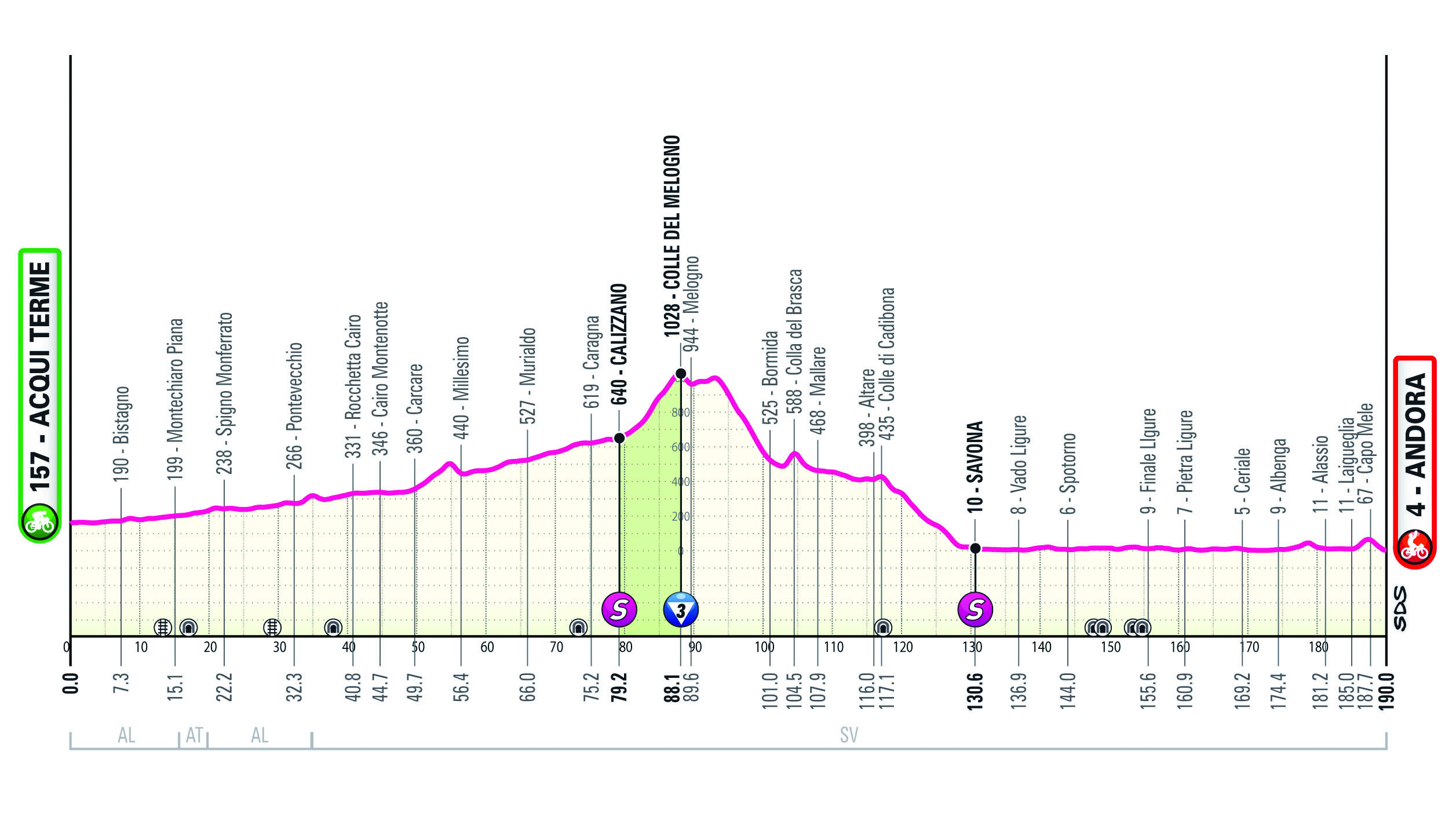
The roads covered were familiar to many cycling fans, as the second half of the stage hugged the same Ligurian coastline that features every spring at the Milan-Sanremo monument.
Whereas that race continues for another 50km or so, towards the Cipressa and Poggio hills that tend to dash the hopes of pure sprinters, this ended abruptly just after the uncategorised Capo Mele climb.
Considering this small hill doesn’t even have an effect as part of that much longer, more energy-sapping race, the sprinters didn't have any problems getting up it today and contesting a bunch sprint.
Despite a late surge from Filippo Ganna, on that Capo Mele climb, the sprinters were able to launch and Jonathan Milan won in Andora.
Stage five: Wednesday 8 May Genova > Lucca I Hilly I 178 kilometres
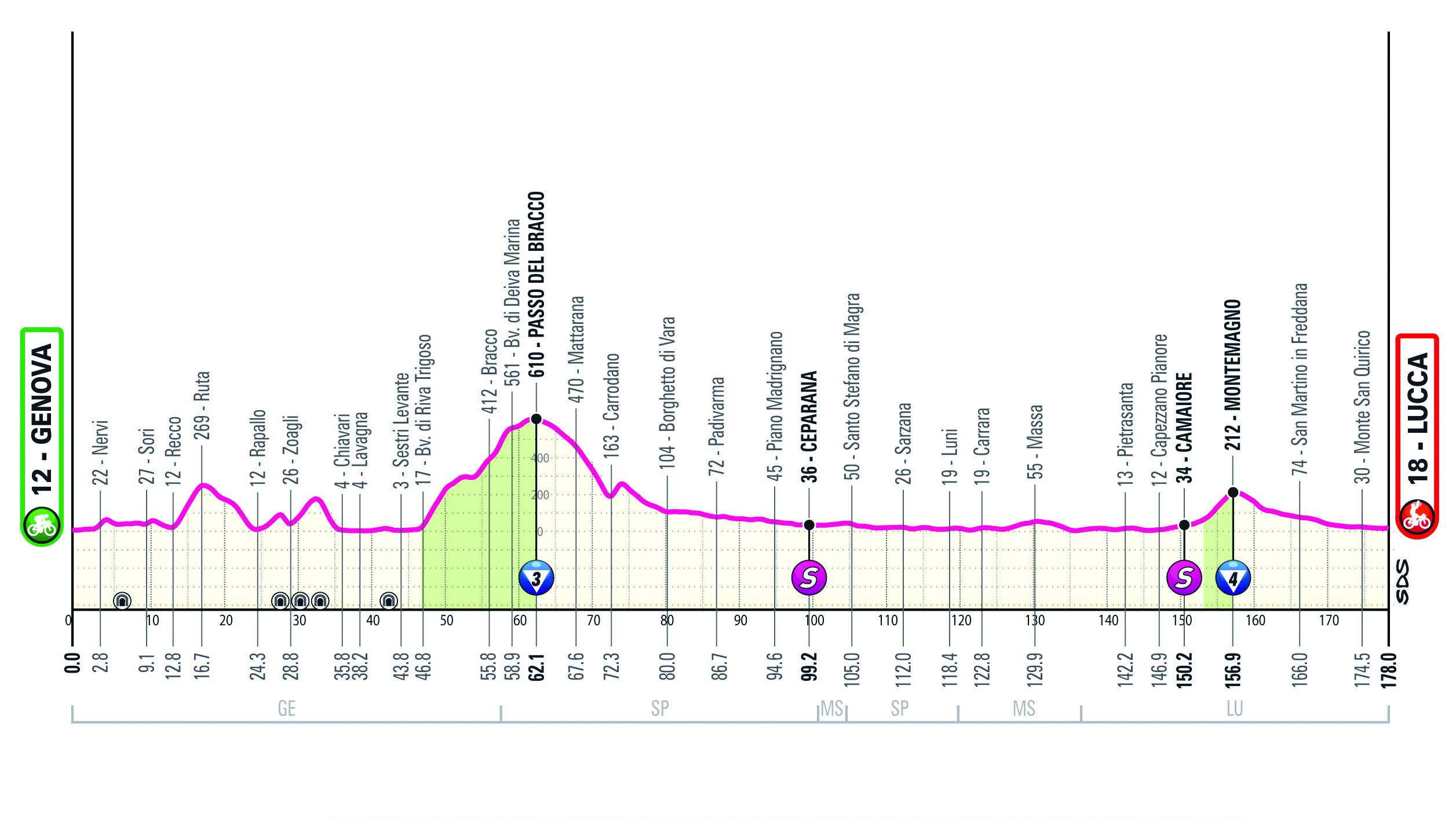
Any sprinter unhappy with missing out on the last two days should have got another chance today – but they should have made the most of it, as this will be the last until stage nine.
They will have to negotiate the lengthy but gentle Passo del Bracco early on, but nobody was distanced when it appeared during a stage of last year’s race, when it featured similarly far from the finish.
The 113km that follow contain no obstacles or traps aside from a 4.7km category-four climb with manageable gradients averaging just 3.6%, meaning a sprint inside the old city walls of Lucca was likely.
However, the breakaway triumphed as the sprint teams messed it up. Benjamin Thomas was the winner.
Stage six: Thursday 9 May Torre del Lago Puccini (Viareggio) > Rapolano Terme I Hilly I 180 kilometres
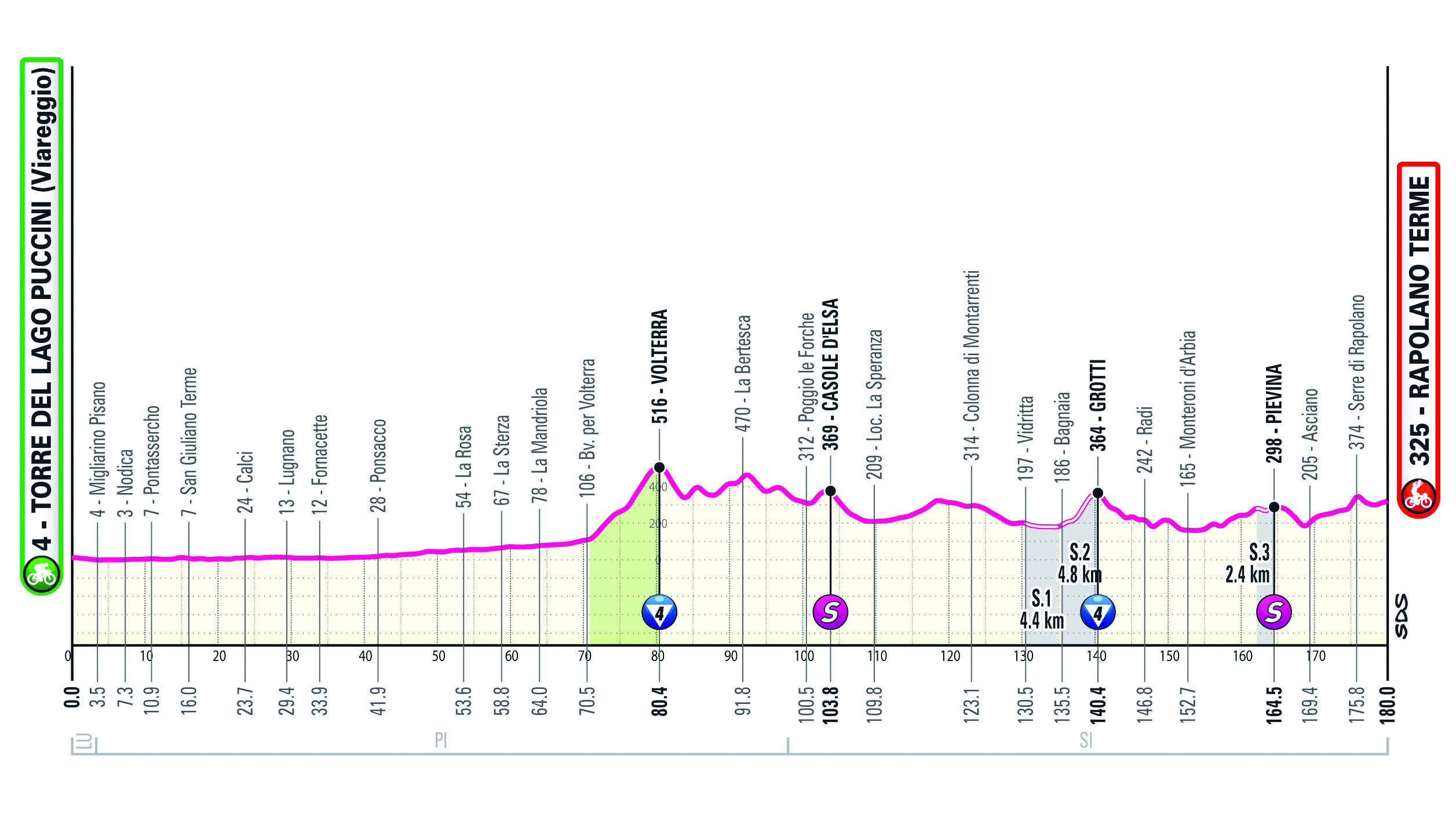
Following Tuesday’s Milan-Sanremo-style stage, Thursday's uses the other great Italian spring Classic as its blueprint – Strade Bianche, and the dirt roads and Chianti Hills of Tuscany that make it such a unique challenge.
These roads wreaked havoc the last time they featured at the Giro, in 2021, when Egan Bernal took control of the race while main GC rival Remco Evenepoel floundered and conceded over two minutes.
This stage wasn't quite so hard, containing three dirt road sectors rather than four, but it could have still been enough to throw a spanner in the works of the GC race and be costly for contenders uncomfortable on the gravel.
In the end, however, there were no splits on the gravel, despite Ineos Grenadiers' best efforts. Pelayo Sánchez of Movistar won the stage, ahead of Julian Alaphilippe (Soudal Quick-Step) and Luke Plapp (Jayco AlUla).
Stage 7: Thursday 9 May Individual time trial Foligno > Perugia 38.5 kilometres
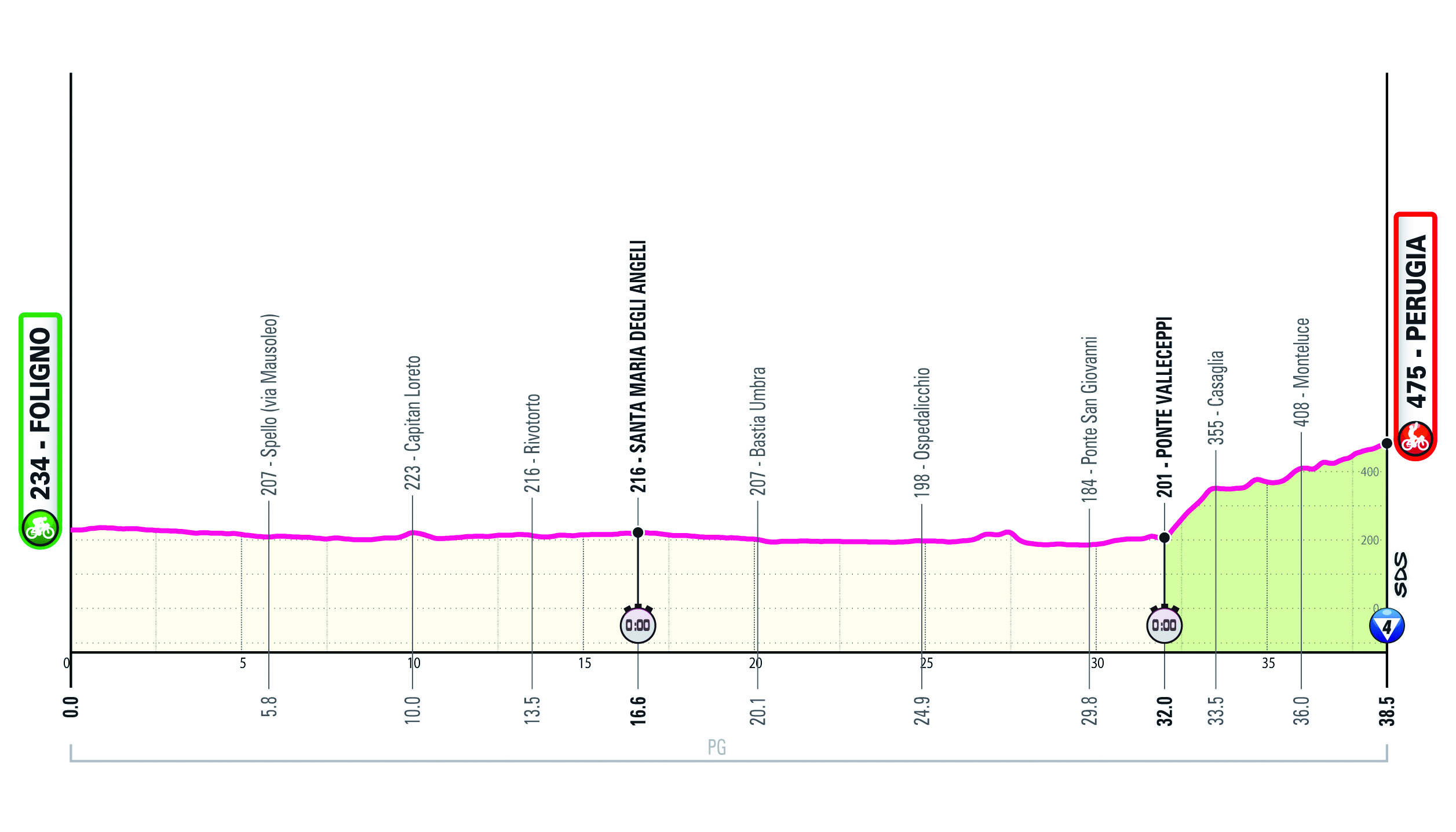
The Giro's longest time trial since 2017 packed a punch that shook the general classification tree, with its 6.5 kilometre climb to the finish in the Umbrian capital of Perugia.
Pogačar extended his lead at the top of the overall standings, nudging his 46-second advantage out to comfortable two minutes and 36 seconds. Dani Martínez (Bora-Hansgrohe) bunnyhopped Geraint Thomas (Ineos Grenadiers) to take second overall, while the Brit, tenth on the day, slipped to third.
What's in a time trial?
While any Grand Tour time trial can offer up some handy GC pointers, a mid-race time trial is a limited barometer. Last year, for example, Remco Evenepoel won the stage nine test, and promptly retired with Covid.
The next most recent mid-race ITT was won by Filippo Ganna in 2020 and then Primoz Roglič in 2019 – neither of whom went on to take victory.
The final TT – often hilly or even mountainous – is often a better indicator. This year's stage 14 test is flat however, and could well baulk that rule.
Today's time trial is the next likely skirmish in the race-long battle for the maglia rosa and will give the bigger boned, bigger-engined GC men something to sink their teeth into. That finishing climb means they won't have it all their own way though, and is likely to play a major role in deciding the day's winner. Its 4.2% gradient means it's hardly mountain goat territory, but it could keep the biggest TT guys off the top podium step.
Starting in Foligno, the riders head north-west on 32km of flat and pretty much straight road, passing a time check in the town of Santa Maria Degli Angelo at 16.6km. At 32km they begin climbing towards the finish in the centre of the beautiful mediaeval city of Perugia.
They will have to kick hard to begin with, with the first 1,500m averaging 10%, before settling into a far more welcome 2.5% for the final five kilometres.
Stage 8: Saturday 11 May Spoleto > Prati di Tivo I Mountains I 153 kilometres
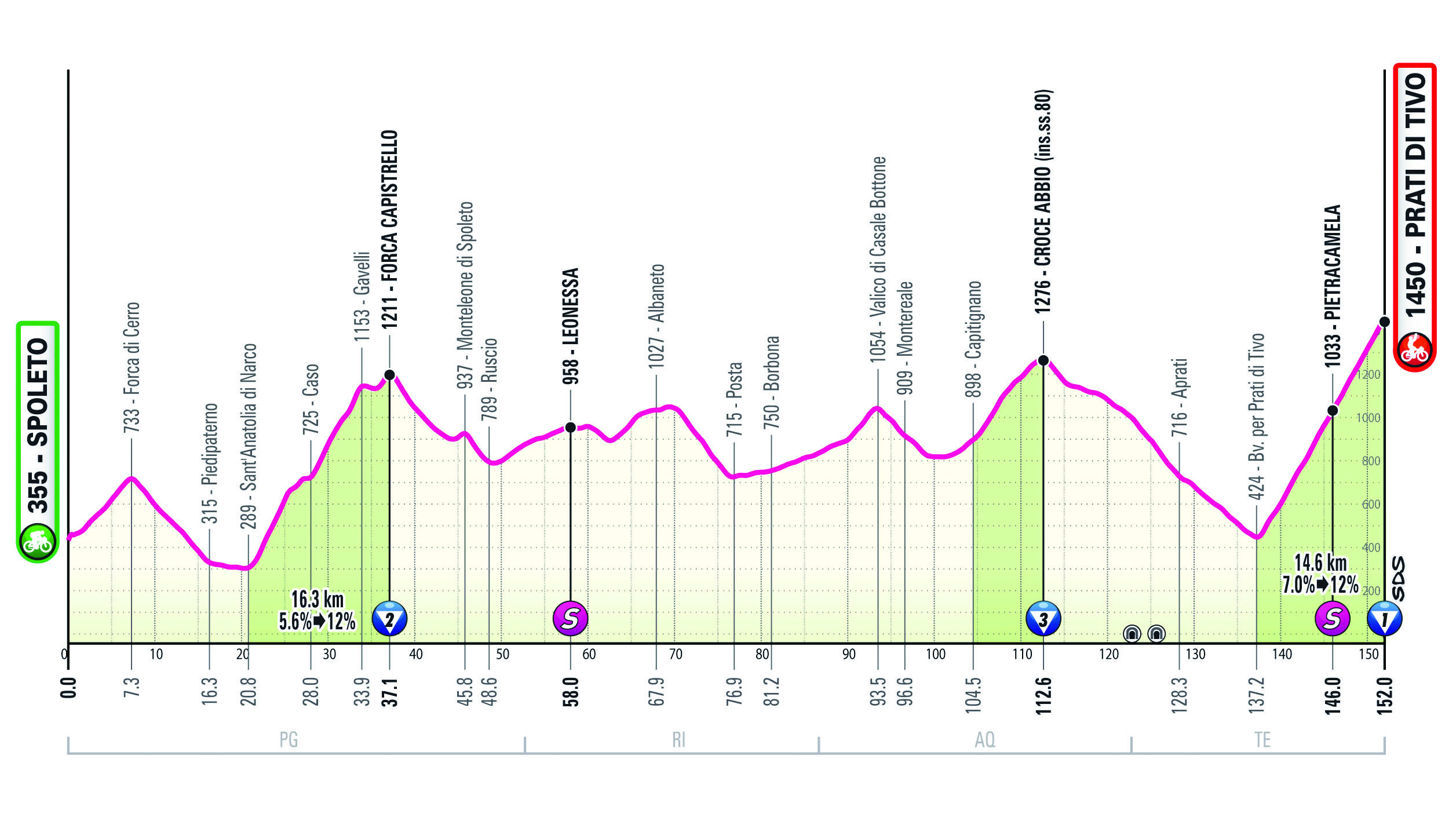
Whereas most of the opening week was spent travelling southwards along the western side of the country, and the second week back up north via the east, stage eight was a rare exception that ventured into the Apennine mountains running through the middle of the peninsular.
As he did on stages two and seven, Tadej Pogačar emerged victorious once again on day eight, this time atop the Prati di Tivo. The climb proved a steady, unforgiving grind that rose at a demanding 7% for over 14km.
Pogačar's victory came from a mountaintop bunch sprint, with Martínez gaining seconds on Thomas in third.
Stage 9: Sunday 12 May Avezzano > Napoli I Hilly I 214 kilometres
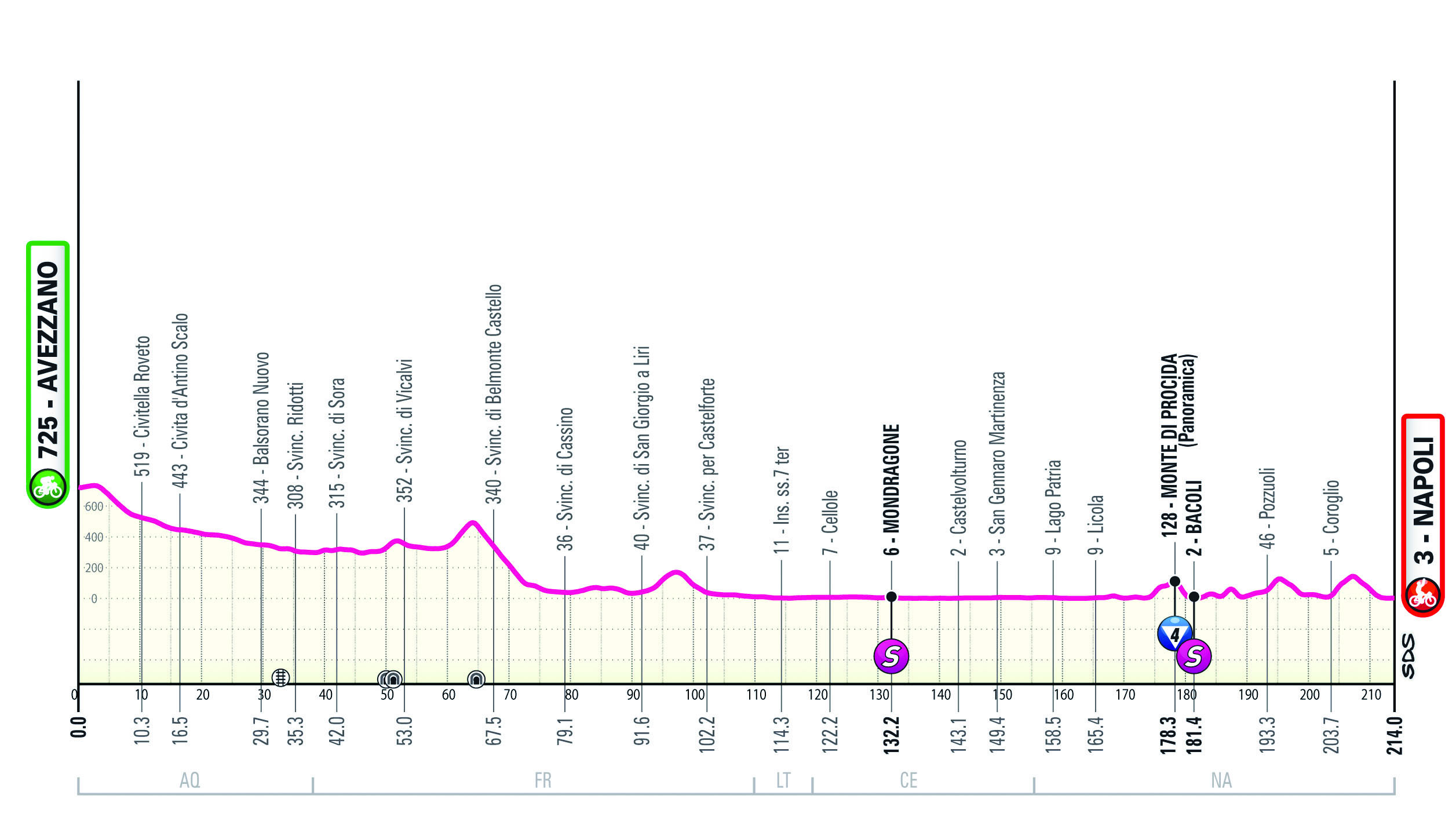
The last two Giro visits to Napoli were finely balanced contests between escapees and sprinters, with the unfortunate Alessandro De Marchi and Simon Clarke denied a mere few hundred metres from the line by a fast-finishing bunch led home by Mads Pedersen last year, and Thomas De Gendt defeating the peloton with a successful break in 2022.
This year the advantage shifted a little towards the sprinters, with less climbing in total, but there was plenty still to make life difficult for them – the stage’s punishing length, the potential for hot, stuffy weather, technical urban roads, and a series of small hills in the final 40km.
Olav Kooij (Visma-Lease a Bike) won the stage, but it was only just a bunch sprint, after Jhonatan Narváez (Ineos Grenadiers) went on the attack with 8km to go.
Stage 10: Tuesday 14 May Pompei > Cusano Mutri I Hilly I 142 kilometres
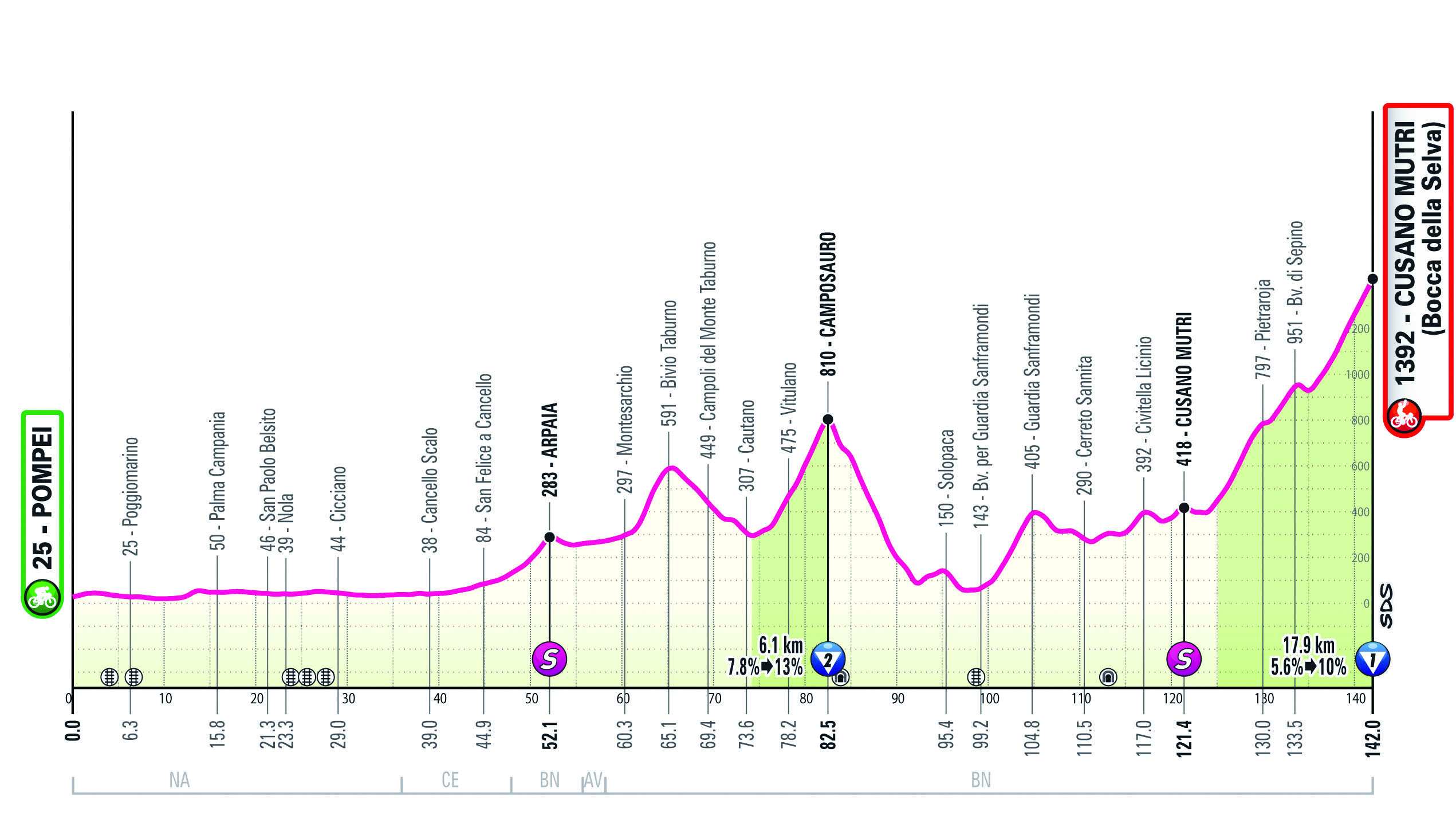
Following yesterday’s rest day, the riders are eased back into racing for what is the second shortest road stage of the race, but with the caveat that the last 18 of those 142 kilometres are spent climbing to the summit finish at Bocca della Selva.
Like many climbs of its excessive length, it’s a mountain of many phases, made up of a gentle first two-thirds preceding a final 6.5km rising at 7.2%, which the favourites would be wise to wait for before attacking.
With heat a potential factor for what is this Giro’s southernmost stage, this will be a sapping day.
Stage 11: Wednesday 15 May Foiano di Val Fortore > Francavilla I Flat I 207 kilometres
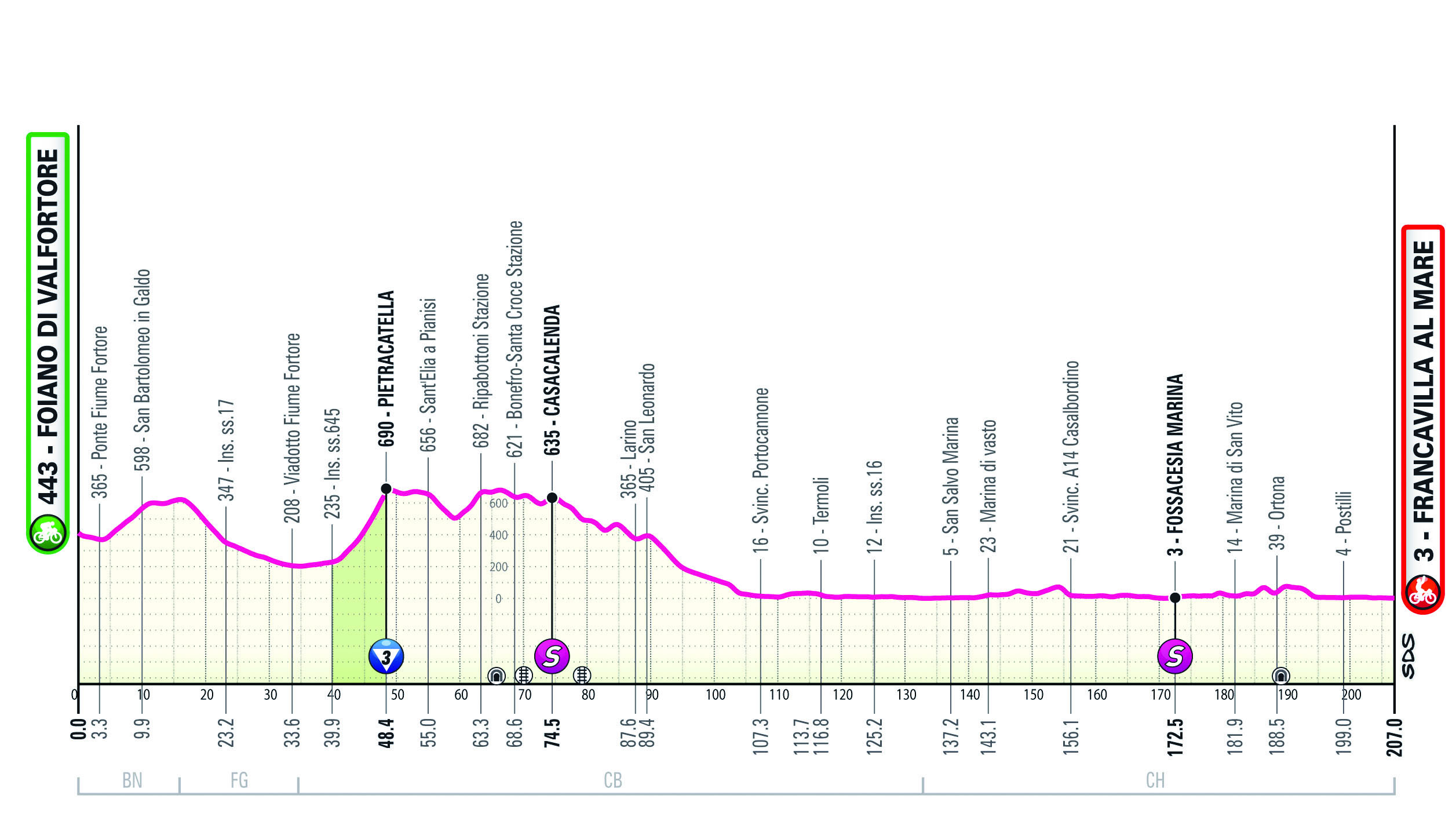
There has been a clear effort this year by the organisers to reduce the length of stages, so much so that today’s lengthy trek northwards through Molise and along the Adriatic coast is one of only four to exceed 200km.
It’s also, save for the shallow 7km San Bartolomeo climb tackled towards the start of the day, completely flat, making it the kind of day TV commentators have nightmares about, as they strain to fill the airwaves against the backdrop of no action.
They’ll be praying the wind blows, which could potentially burst the race into life during the final 100km of exposed coastal roads.
Stage 12: Thursday 16 May Martinsicuro > Fano I Hilly I 190 kilometres
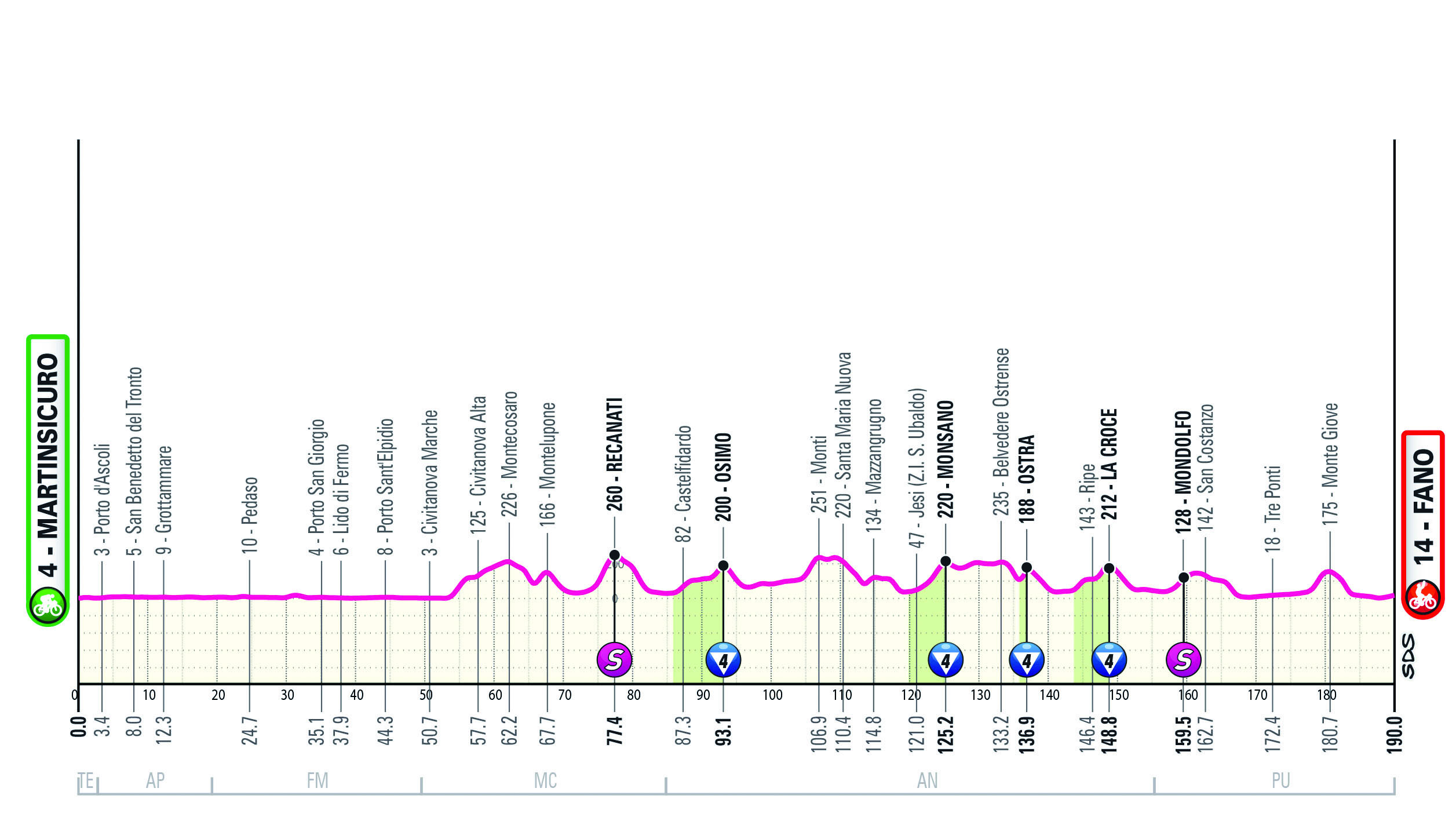
Italians use the phrase ‘tappa dei muri’ to describe a parcours like today’s: a ‘stage of walls’, a kind of death by thousand cuts in which rather than being exposed to one, big climb, the riders must take on multiple small hills.
There are four climbs officially, and many more uncategorised rises, meaning this will be a day for the puncheurs or the sprinters, either via an early breakaway or out of the peloton with a late attack. And who knows, maybe even a brave GC contender will use the steep ramps of one of the late rises to try and gain some time?
Stage 13: Friday 17 May Riccione > Cento I Flat I 179 kilometres
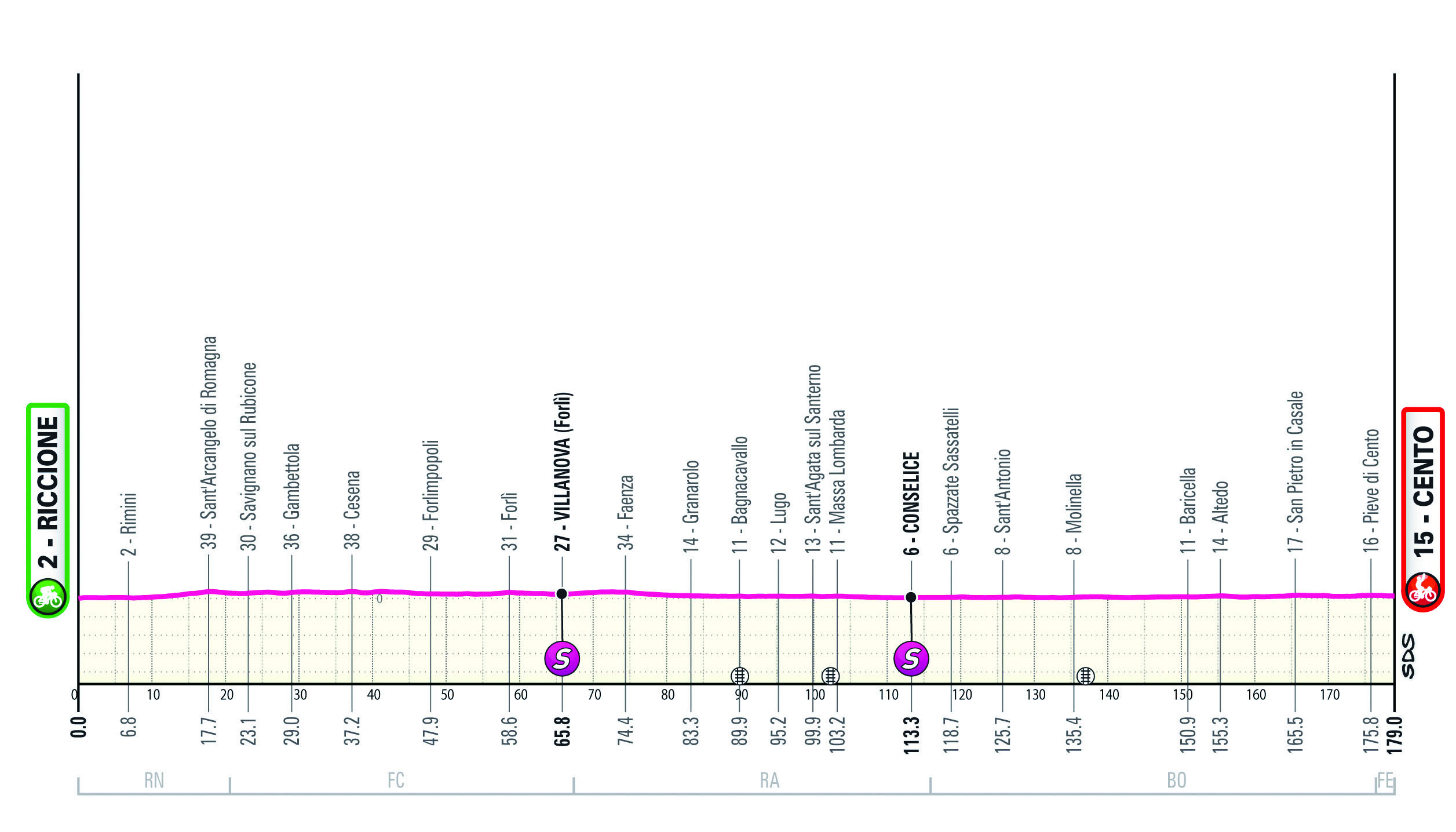
The second week’s long journey north continues with a stage through the plains of Emilia-Romagna that is one the flattest days of the whole Giro. It’s therefore surely one for the sprinters, as was the case the last time Cento hosted a stage finish 29 years ago when Ján Svorada was awarded victory after Mario Cipollini was relegated for dangerous riding.
It’s the last chance for a bunch sprint for almost a week, and for some the last of the race – there will be those who give into the temptation to navigate the closely-looming Alps via an aeroplane home rather than by bike.
Stage 14: Saturday 18 May Castiglione Delle Stiviere > Desenzano del Garda I Individual time trial I 31.2 kilometres
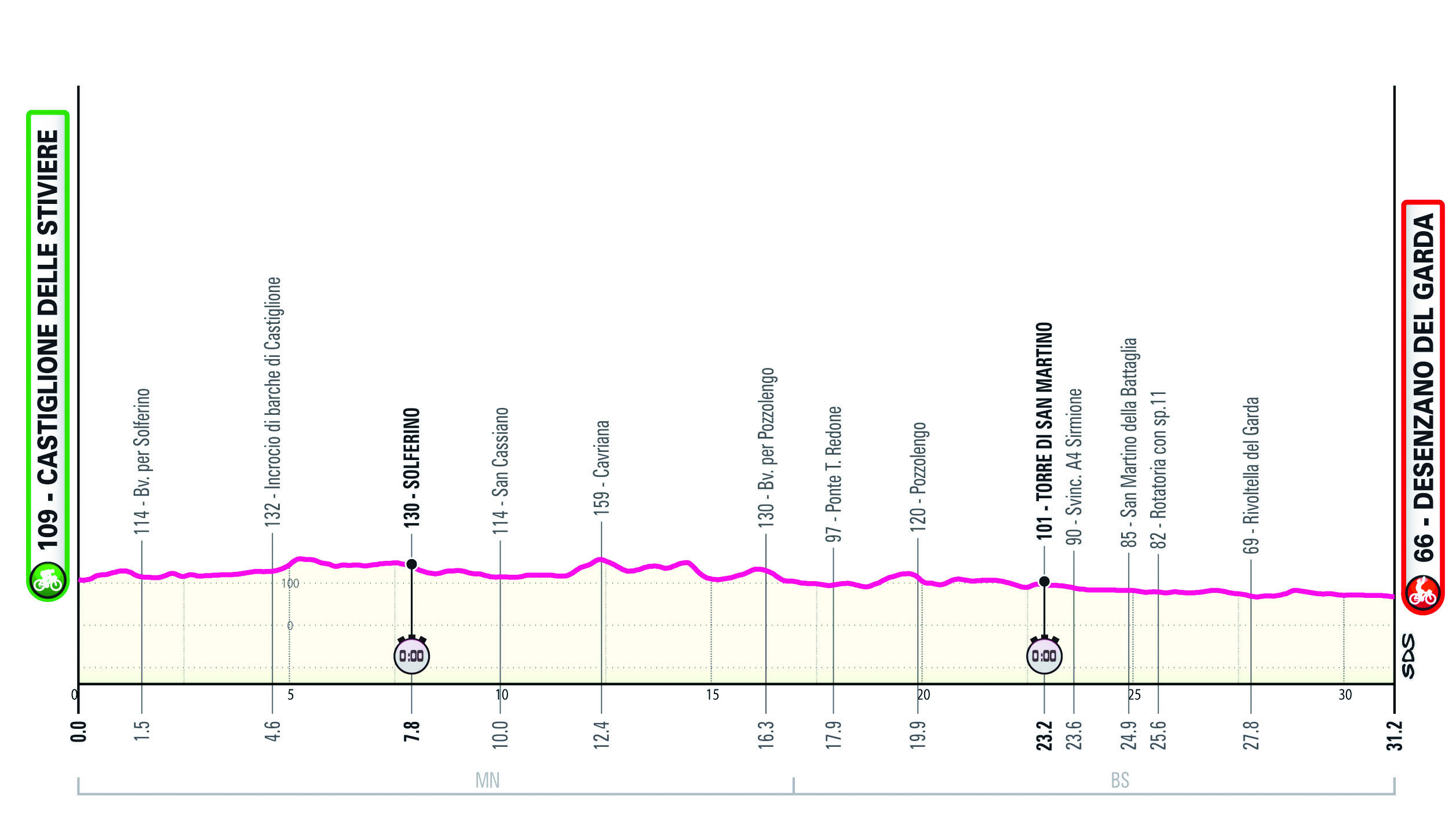
“Of the two [time trials]”, said former world champion and home favourite Filippo Ganna at the route presentation, “the one in Desenzano is the most suitable for me”, and it’s easy to see why.
This is flatter than stage seven’s time trial in Perugia, without a single climb to break the riders’ rhythm, and contains multiple twists and turns to further aid specialists with more refined techniques.
If the GC favourites are evenly matched in the mountains, this could be the decisive stage of the race – although a similarly long and flat time trial last year saw them separated by mere seconds.
Stage 15: Sunday 19 May Maberba del Garda > Livigno (Mottolino) I mountains I 220 kilometres
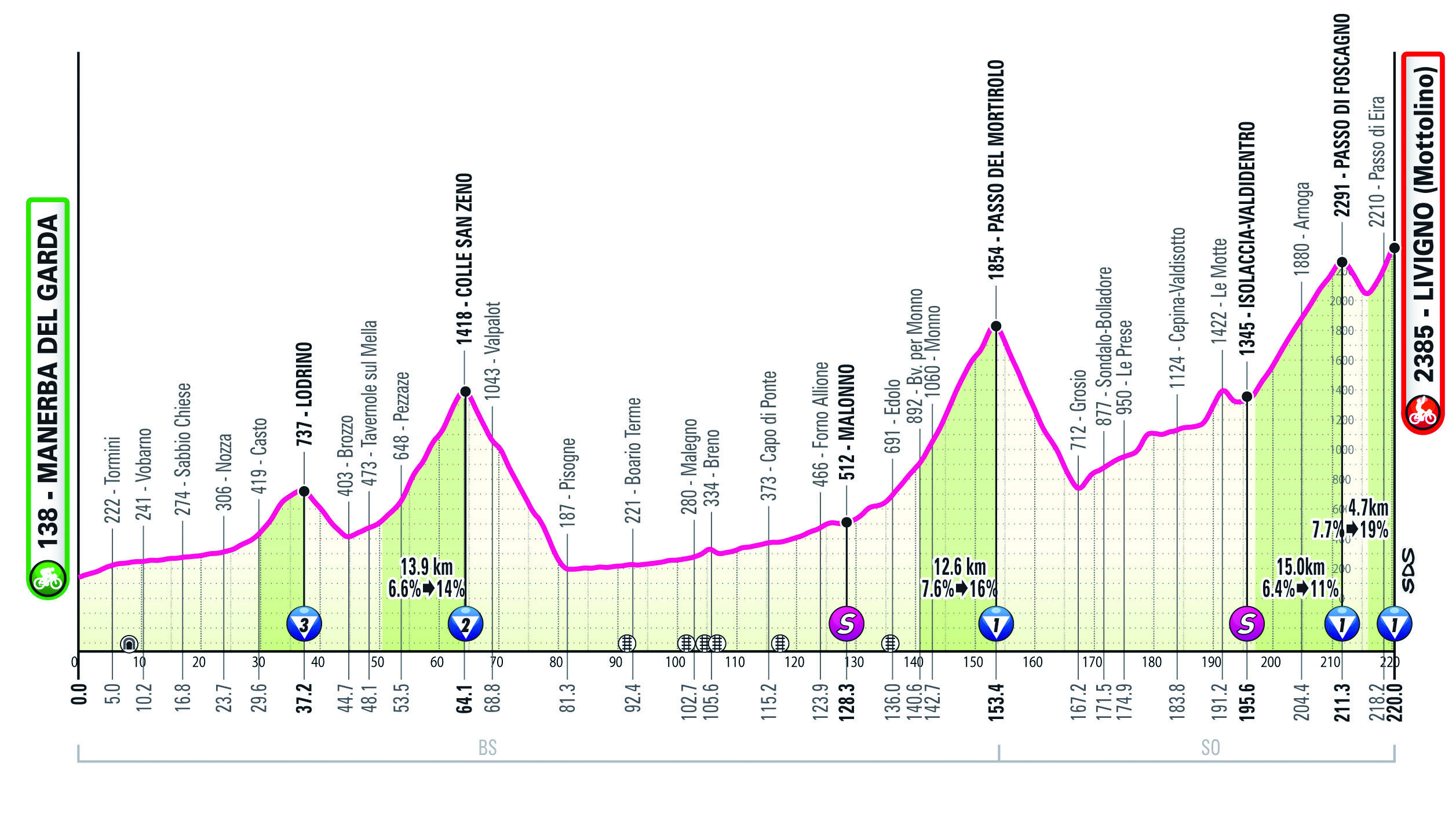
Stage 15 brought the longest and most challenging stage of the race. It counted five climbs, the highlights being the mighty Mortirolo (albeit via its ‘easier’ side) and similarly massive Passo di Foscagno.
For the fourth time at the race, Tadej Pogačar (UAE Team Emirates) prevailed with a stage win, this time attacking with 14km to go and soloing, past the breakaway, and onto victory in Livigno. "[It's] one of my favourite places in Italy," he said afterwards.
Stage 16: Tuesday 21 May Livigno > Santa Cristina Valgardena I Mountains I 206 kilometres
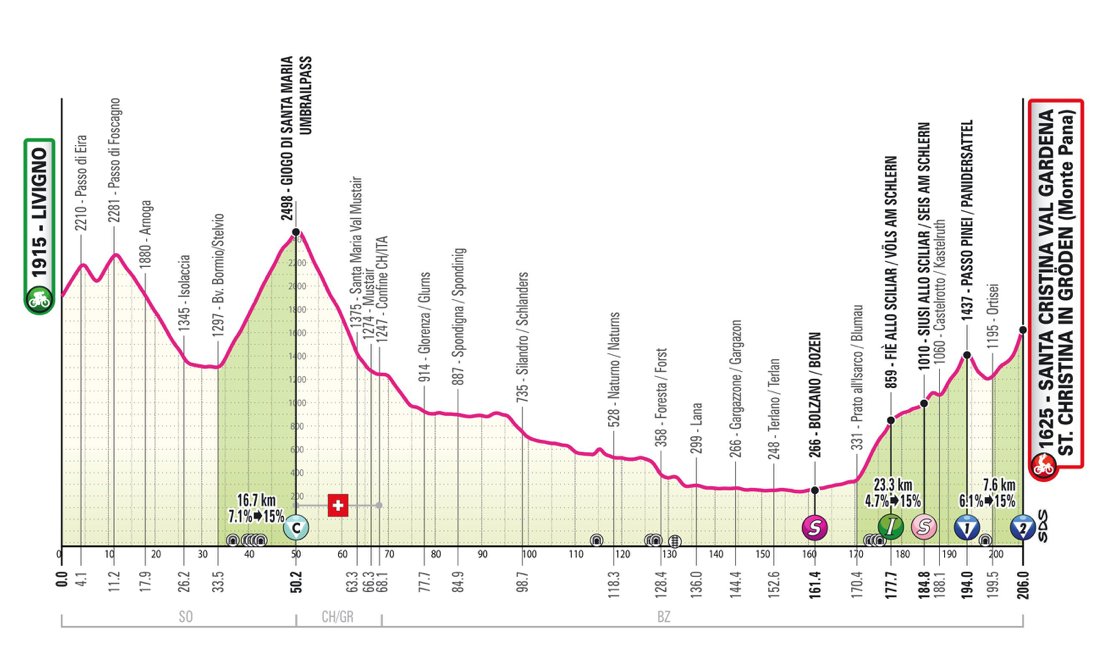
This mountain stage would have been hard enough without the additional boast of being one of just four stages coming in over the 200km mark.
Again, Tadej Pogačar was victorious at the Giro d'Italia, claiming back-to-back victories after tagging Giulio Pellizzari (VF Group-Bardiani CSF-Faizanè) on the Monte Pana.
The rest day blues
This year's Giro d'Italia features the Grand Tour standard two rest days, coming on the Mondays of the second and third weeks.
You might imagine the riders kicking back in a pavement cafe or sleeping the day away. No chance. That could trick the body into entering recovery mode – not what a GrandTour rider wants when there's a mountain stage the next day.
Solution? Go for a ride – a proper one. On last season's Giro d'Italia for example, Sepp Kuss (Jumbo-Visma) rode 60km (37.5 miles) on the first rest day.
Those vulnerable riders will be put to the sword in the most severe fashion early on in the stage as the peloton meets the infamous Stelvio climb, which they begin climbing with 33km done and do not finish until a shade over 20km later, having averaged 7.2% along the way, and overcome gradients of up to 15% halfway up. Coming so early in the stage, GC attacks are unlikely, though anyone with bad legs after the rest day could easily find themselves distanced. Equally the climb could act as the springboard for the day's break, but they will need a major gap when they reach the final 35km if they want to stay away.
This is where they'll meet the cat-one Passo Pinei (23.4km / 4.9%) and the cat-two finish climb of Santa Cristina (7.6km / 6.1%), both featuring 15% slopes. The maglia rosa is unlikely to be won today, but there will be nervous riders on the start line in Livigno and by the end of the stage the GC hopes of more than one rider are likely to have been tempered.
Stage 17: Wednesday 22 May Selva di Valgardena > Passo del Brocon I Mountains I 159 kilometres
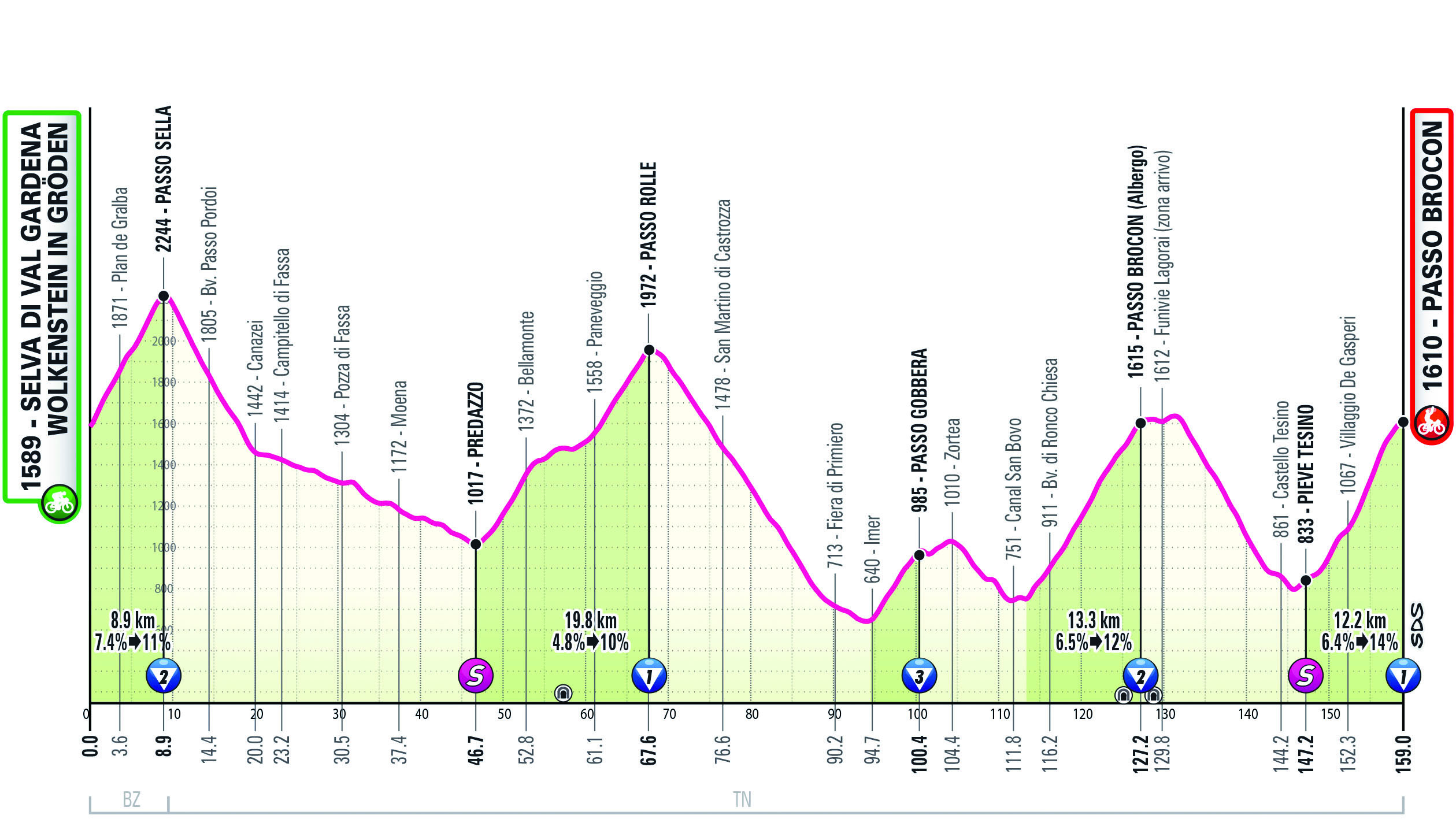
With five climbs in the high mountains, stage 17 looked set to form a key battleground in the general classification.
In the end, it was Georg Steinhauser (EF Education-EasyPost) who won, attacking alone on the penultimate climb of the day. There was GC action, though, with Tadej Pogačar extending his advantage over his rivals to almost eight minutes.
Key climb
One of the numerous climbs familiar to anyone who has ridden the famous Maratona dles Dolomites challenge ride, the Passo Sella is 9km long at 7.3% and crucially tops out at 2,244m.
It will be taken at anything but leisurely pace on today's stage, and riders will be warming up thoroughly around the team buses beforehand, ready for a potential out-of-the-blocks onslaught as those GC leaders who are feeling good seek to catch out those who don't.
In their own special way, these three are all pretty much as hard as the other. Starting at Val Gardena, not far from the Austrian border, the race plunges south, taking on the Passo Sella straight out of the blocks (see boxout). Having reached the summit the riders enjoy a near-40km descent to the foot of the Passo Rolle. This is long, at 19.8km, with a low average gradient of 4.6%, in part due to a few kilometres of respite halfway up.
The cat-three Passo Gobbera will be tackled as a matter of course before the riders take on the Passo Brocon for the first time – from the north-west – before looping south and coming at it again from its harder approach, this time for the stage finish.
Stage 18: Thursday 23 May Fiera di Primiero > Padova I Flat I 171 kilometres
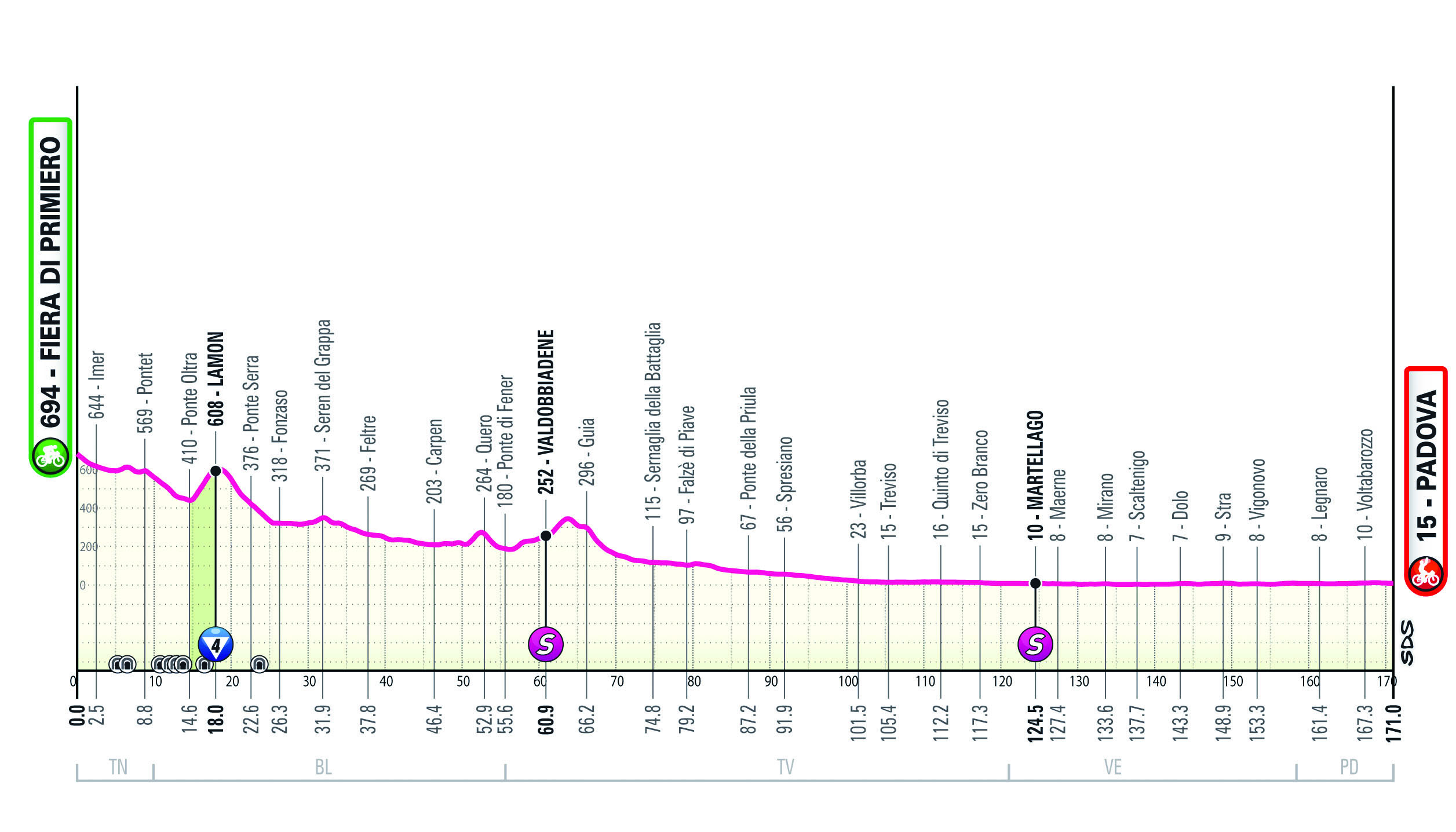
There was nothing to encourage breakaways in stage 18's parcours, which brought the riders out of the Alps while studiously avoiding the hills of the local Prosecco vineyards.
The race's two strongest sprinters locked horns once again in Padova, this time Tim Merlier (Soudal Quick-Step) taking the spoils over Jonathan Milan (Lidl-Trek). The victory brought the stage win tally to 3-2 in favour of Milan.
Stage 19: Friday 24 May Mortegliano > Sappada I Hilly I 157 kilometres
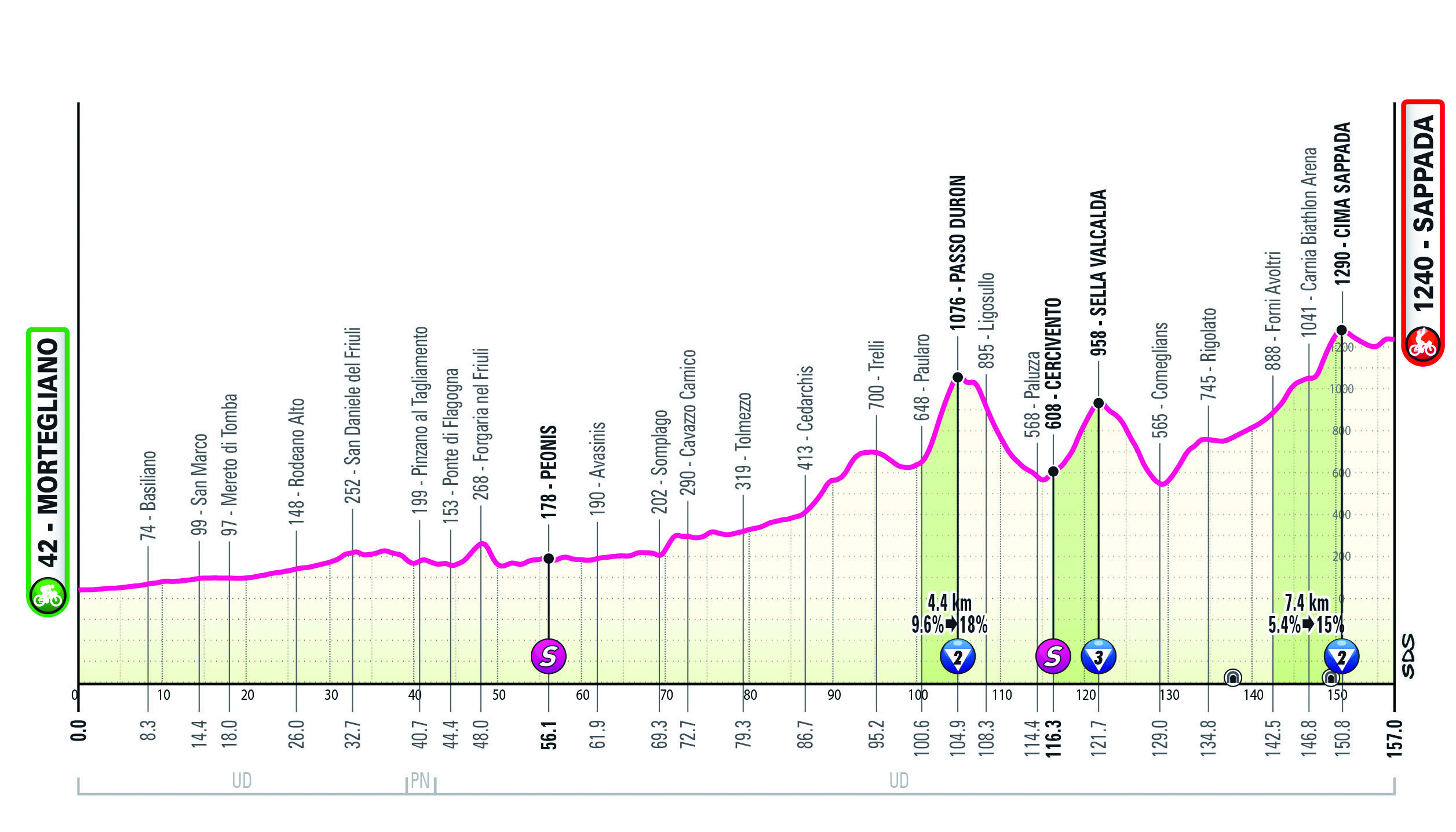
The riders headed back into the Alps on stage 19, but the climbs weren't tough enough to ignite the GC battle. The Passo Duron was too short and Cima Sappada too shallow to be rated higher than a category two, and the steepest 3km stretch of over 8% on the latter comes perhaps too far from the finish (7km) to incentivise attacks.
With a 30km attack, Andrea Vendrame (Decathlon AG2R La Mondiale) wriggled free from his fellow escapees to claim a solo win in Sappada. The GC riders rolled him almost 16 minutes later, content to concede the day to the breakaway.
Stage 20: Saturday 25 May Alpago > Bassano del Grappa I Mountains I 181 kilometres
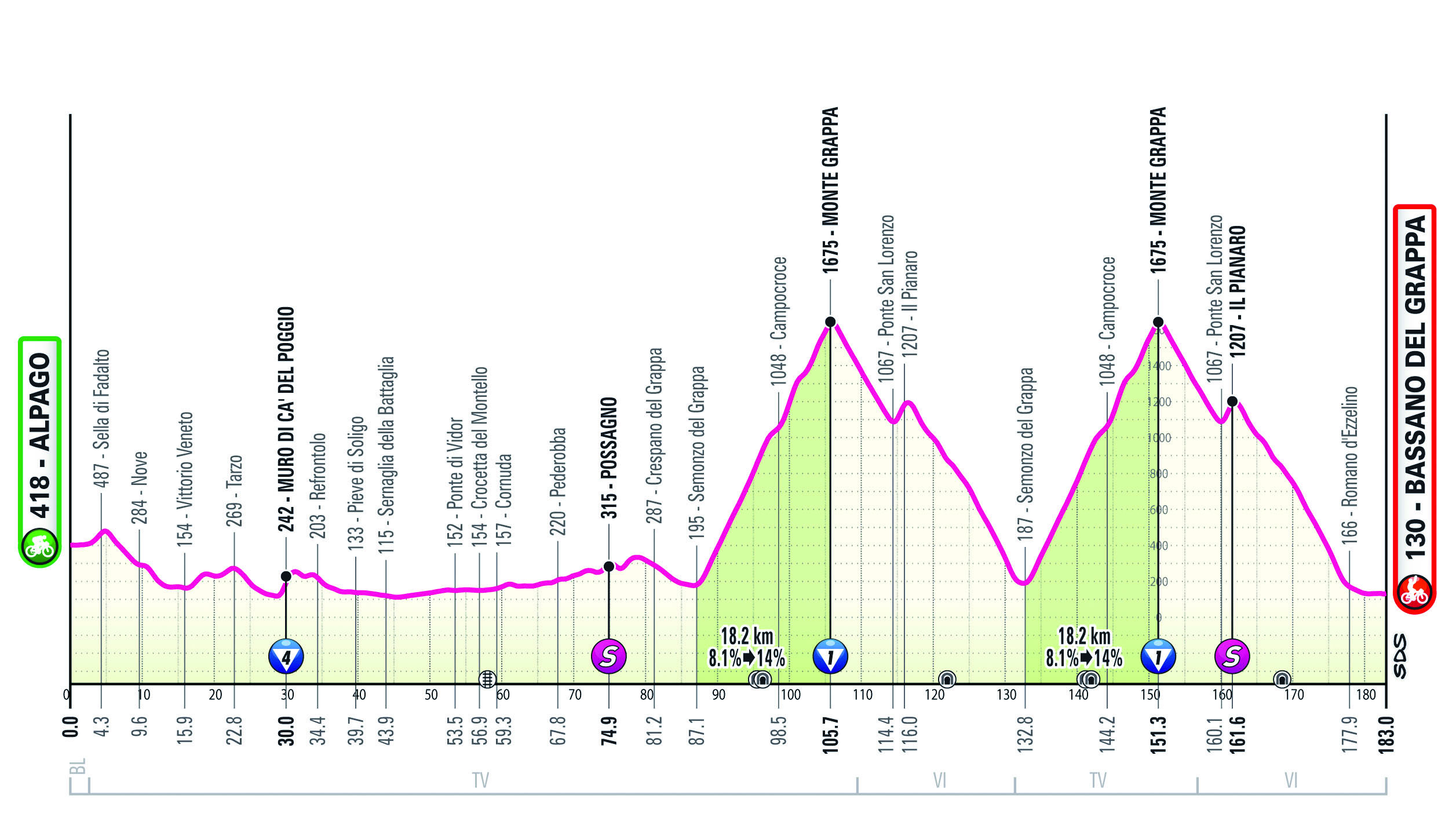
It may not be a summit finish but there is little doubt that whoever wins this outlandish stage will be a super climber – and utterly spent by the end of it. Not unlike the archetypal football match, this is a stage of two halves. The first is a story of comparatively flat terrain, with a few lumps near the beginning – including the category-four climb of Muro di Ca'del Poggio (no relation) after 30km.
The 'fun' begins at 85km, very close to the halfway mark, as the riders embark on the first ascent of the mammoth cat-one Monte Grappe climb. Its 18.5km slopes begin all the way down at 187m above sea level, averaging a relentless 8% right up to the top at 1,675m. In particular, fans will delight and riders will despair at the final four kilometres, which average a brutal 9.5% and feature slopes of up to 17%.
Monte Grappa - the power of 10
Tough as the Giro's riders will find Monte Grappa today, they should perhaps be grateful that organisers did not present them with a tougher route up it.
There are 10 different approaches to the climb, three of which average 10% – and they're all longer too.
Amateur riders can earn a gold Brevetto del Monte Grappa by completing all of these ascents, with silver and bronze also available for those taking on six or three respectively.
What's more, when this beast has been dispatched, the riders will find themselves looping around the base of it to begin the undertaking all over again. Once it has been tackled twice they will find a 25km descent with a handful of flat kilometres to the finish awaiting them, during which time a lot can happen.
The GC riders will need to be ready to battle hard on that last downhill, and there could be a number of heart-in-mouth moments before the winner of the stage – and indeed the final maglia rosa (for tomorrow is a flat, processional stage in Rome) – is decided.
Stage 21: Sunday May 26 Rome > Rome I Flat I 122 kilometres
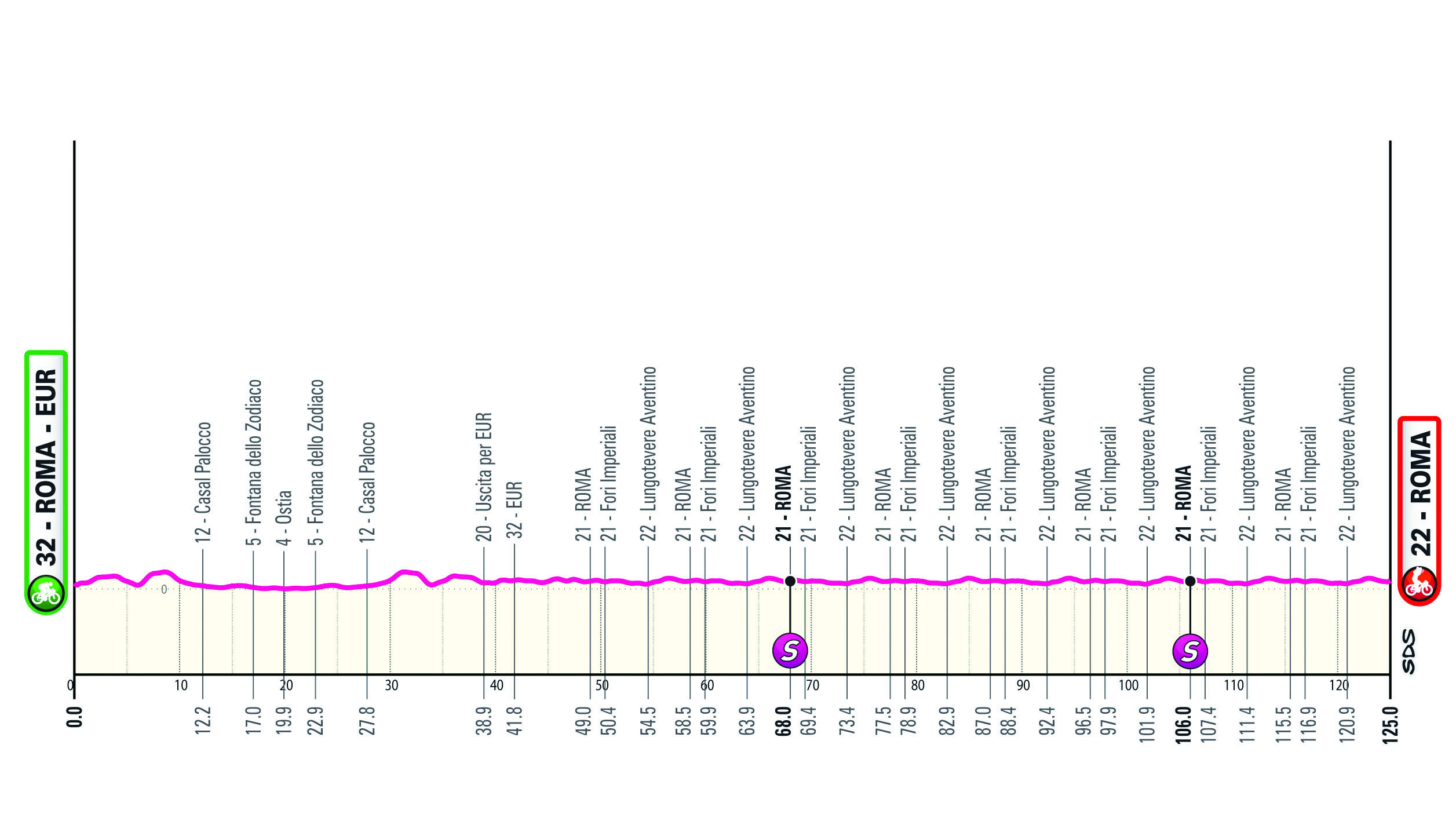
Rome again hosts the finale of the Giro, where last year Mark Cavendish, ever the man to rise to the occasion, triumphed on his last ever day at the Giro. The circuit this year is a little different, but fundamentally the same, in that it’s flat and sure to end in a sprint.
The twisty urban roads mean the sprinters will need a teammate (or, as Cavendish found in Geraint Thomas last year, an old friend) to help guide and protect them, before being unleashed on the Champs Elysees-esque finishing straight along the lightly cobble Via di San Gregorio against the picturesque backdrop of the Colosseum.

Thank you for reading 20 articles this month* Join now for unlimited access
Enjoy your first month for just £1 / $1 / €1
*Read 5 free articles per month without a subscription

Join now for unlimited access
Try first month for just £1 / $1 / €1
After cutting his teeth on local and national newspapers, James began at Cycling Weekly as a sub-editor in 2000 when the current office was literally all fields.
Eventually becoming chief sub-editor, in 2016 he switched to the job of full-time writer, and covers news, racing and features.
A lifelong cyclist and cycling fan, James's racing days (and most of his fitness) are now behind him. But he still rides regularly, both on the road and on the gravelly stuff.
- Tom ThewlisNews and Features Writer
-
 Aero bikes with gravel wheels?: Six tech insights from Paris-Roubaix Femmes
Aero bikes with gravel wheels?: Six tech insights from Paris-Roubaix FemmesEverything we found out about tyre widths, self-inflating systems, and wheel choices from the cobbled Monument
By Tom Davidson Published
-
 'This race is absolutely disgusting': Peloton reacts to another brutal Paris-Roubaix Femmes
'This race is absolutely disgusting': Peloton reacts to another brutal Paris-Roubaix FemmesNow in its fifth edition, Paris-Roubaix Femmes is still a tough race, even for the best bike riders in the world
By Adam Becket Published
-
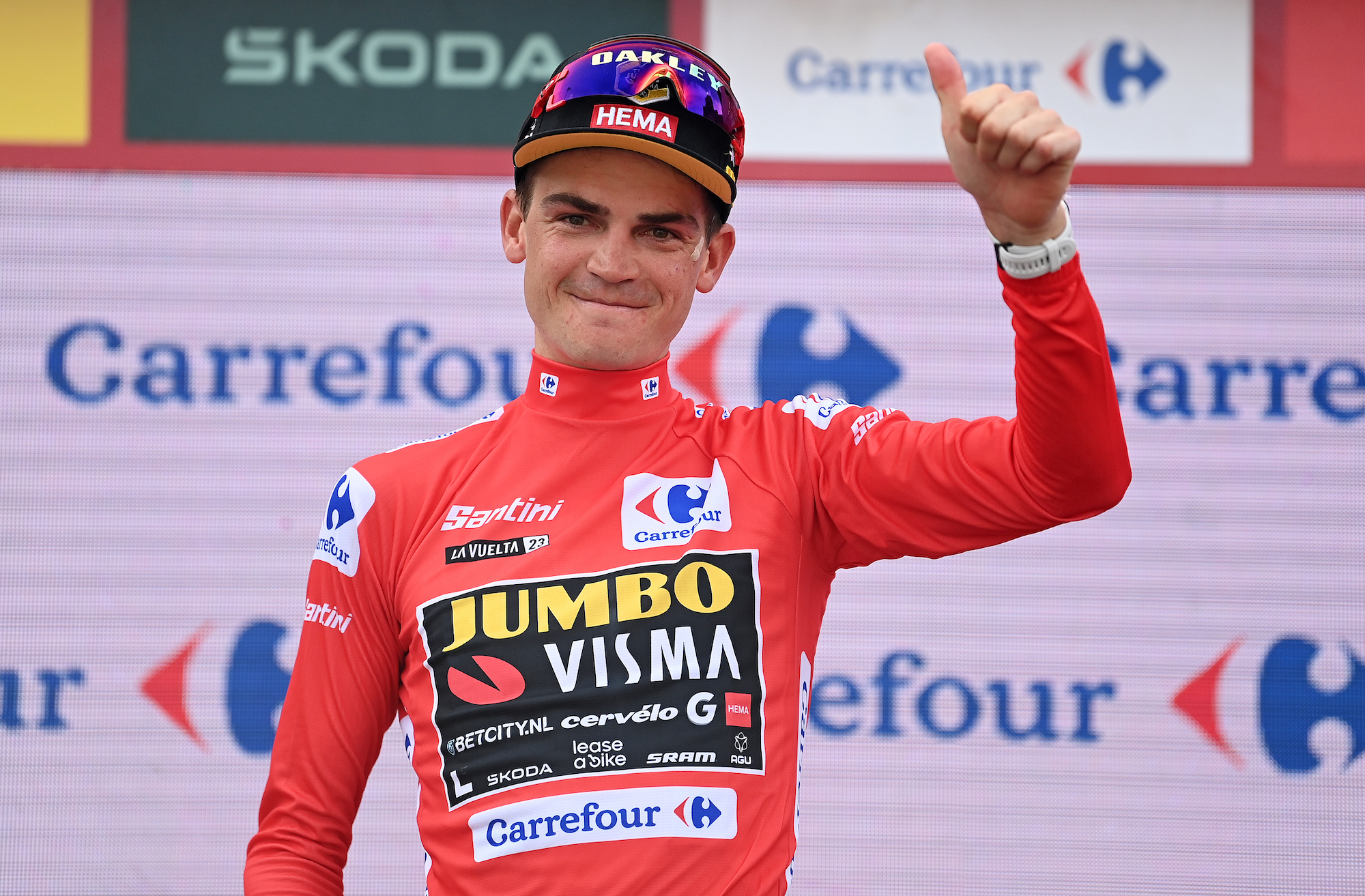 How to watch the Vuelta a España live stream 2024
How to watch the Vuelta a España live stream 2024All the information you need in order to tune into the Spanish men's Grand Tour
By Tom Thewlis Published
-
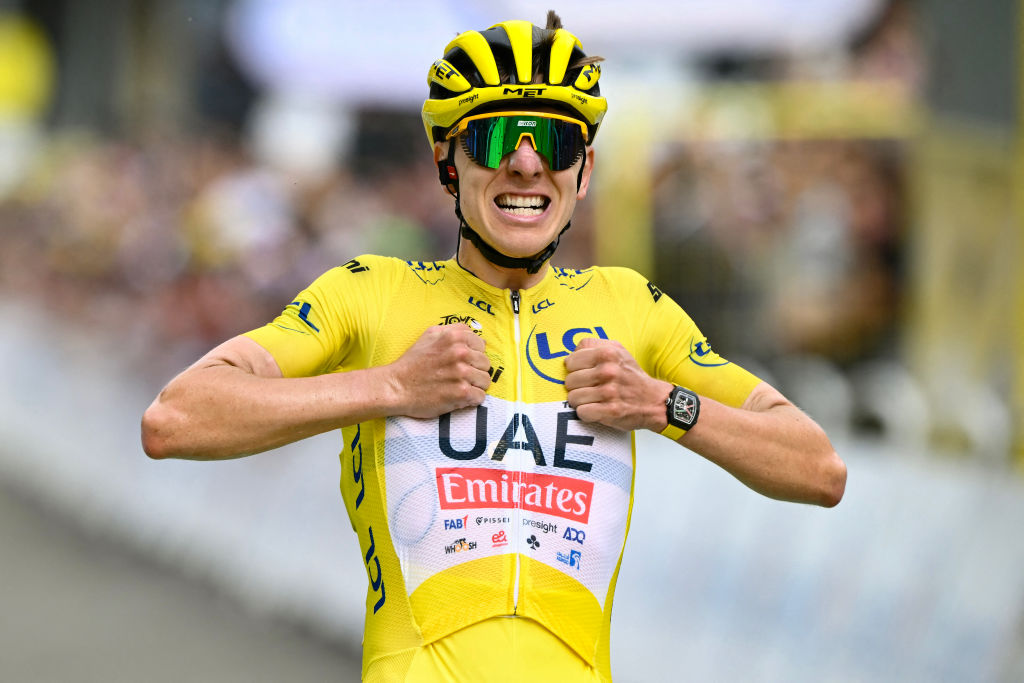 Coppi, Pantani, Van Vleuten, Pogačar: A look at the Giro-Tour double winners club
Coppi, Pantani, Van Vleuten, Pogačar: A look at the Giro-Tour double winners clubTadej Pogačar has now officially joined the club, becoming the eighth man to achieve one of professional cycling’s most sought after accolades
By Tom Thewlis Published
-
 Tweets of the week: Grandpa Geraint Thomas, a fox at the Giro d'Italia, and the greatest camera shot ever
Tweets of the week: Grandpa Geraint Thomas, a fox at the Giro d'Italia, and the greatest camera shot everAs the dust settles on the Giro d'Italia, it's the Tour of Norway that grabs our attention
By Tom Davidson Published
-
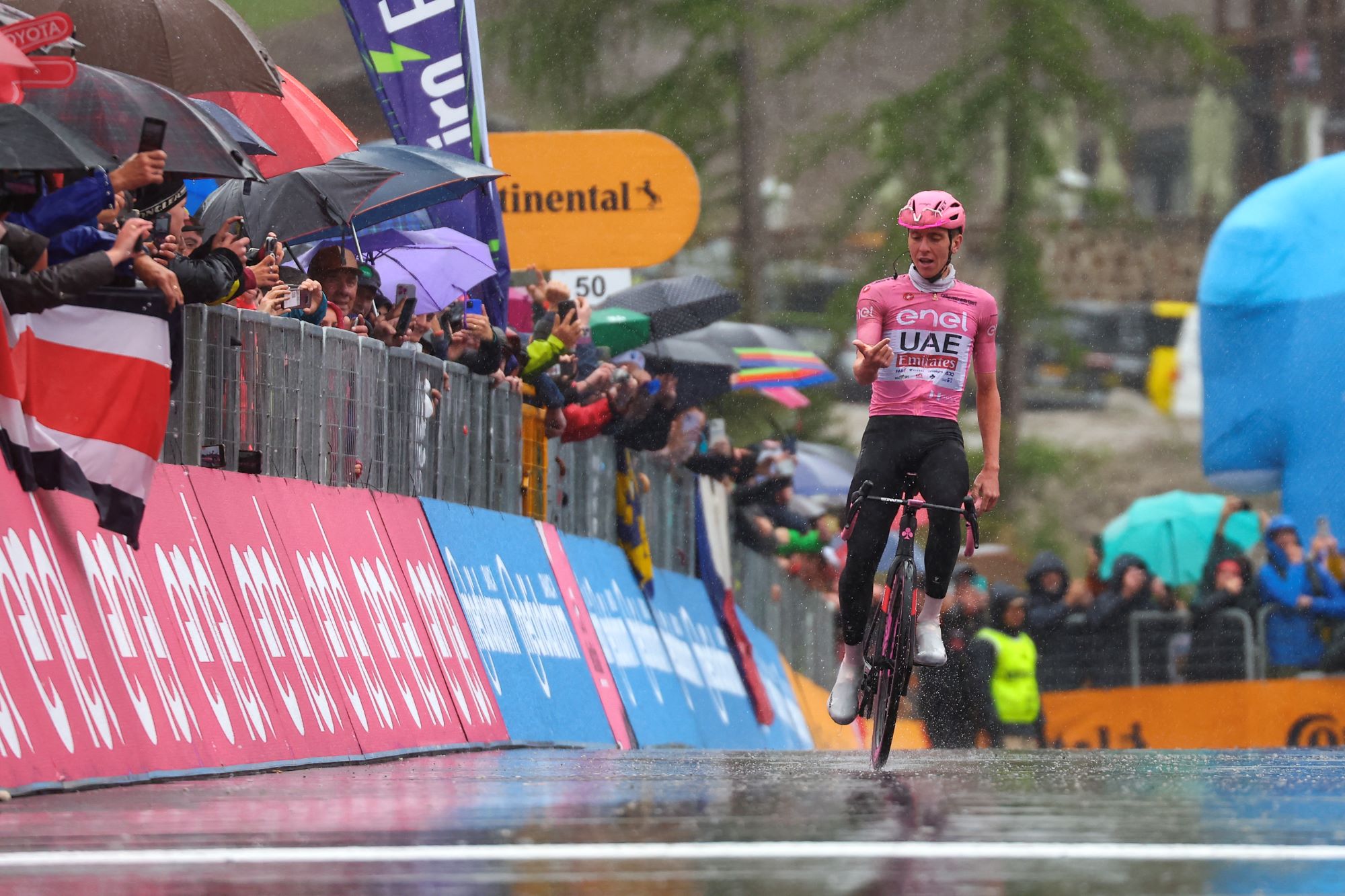 'Haters gonna flag' - Tadej Pogačar flagged again on Strava after dominant ride at Giro d’Italia
'Haters gonna flag' - Tadej Pogačar flagged again on Strava after dominant ride at Giro d’ItaliaSlovenian flagged after queen stage victory in Livigno before being flagged on stage 17 in the Dolomites
By Tom Thewlis Published
-
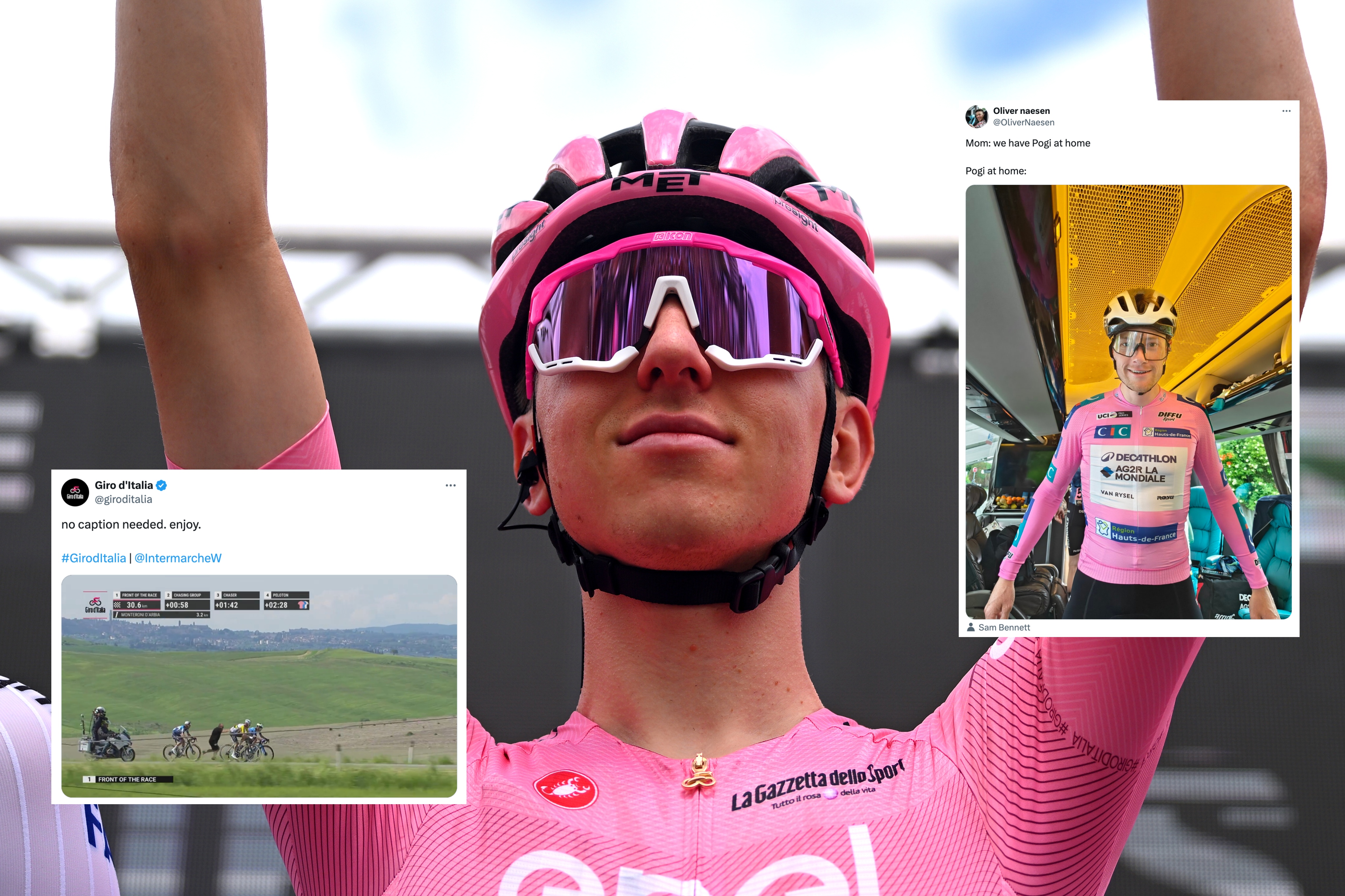 Tweets of the week: In praise of the Giro d'Italia Twitter account
Tweets of the week: In praise of the Giro d'Italia Twitter accountWhen it comes to social media game, the Giro d'Italia is the best Grand Tour
By Tom Davidson Published
-
 Tweets of the week: Patrick Lefevere hands out the bidons, pink sunglasses, and the kids are alright
Tweets of the week: Patrick Lefevere hands out the bidons, pink sunglasses, and the kids are alrightAll the action from cycling social media in the last 7 days
By Tom Thewlis Published
-
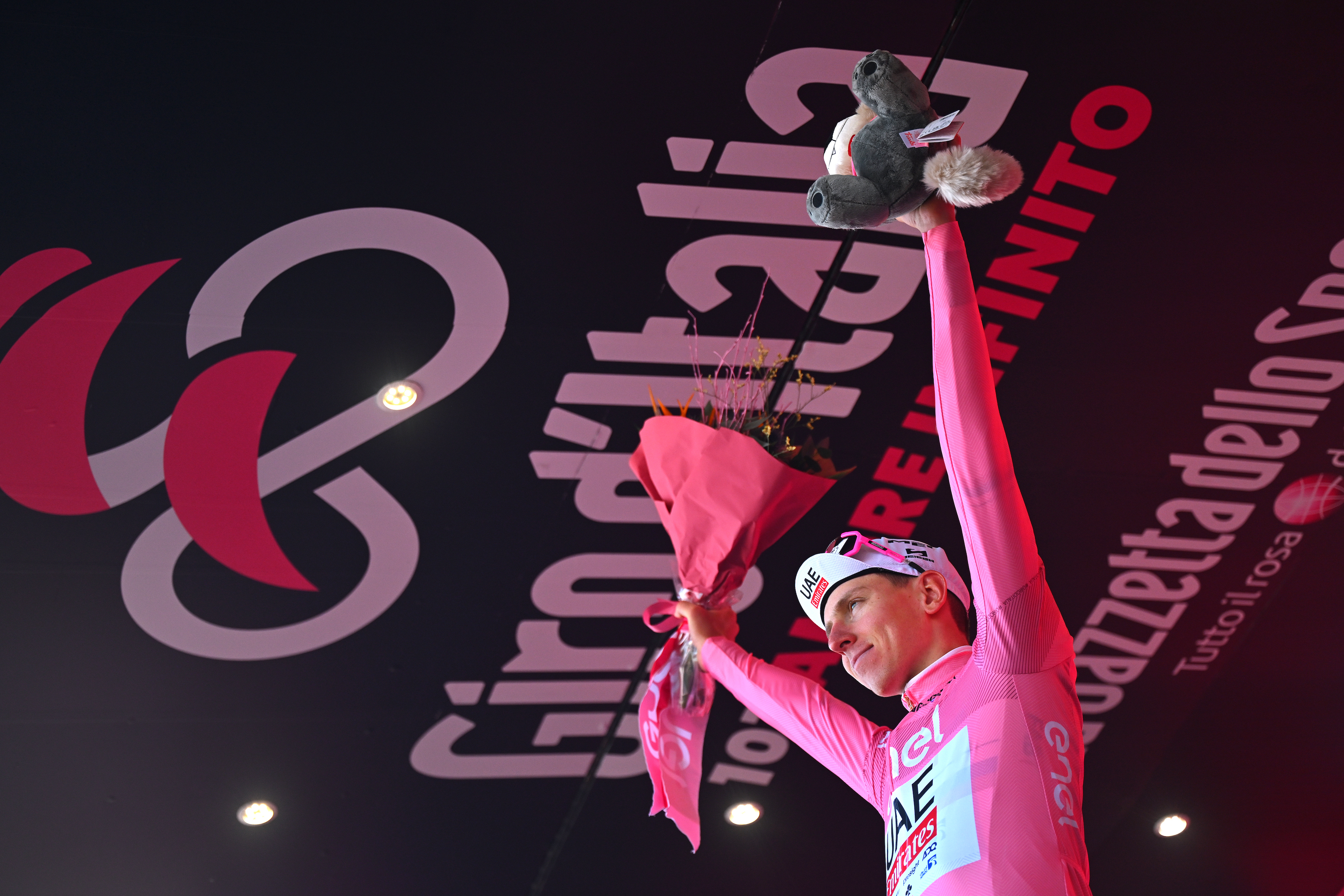 How to watch the Giro d'Italia live stream 2024
How to watch the Giro d'Italia live stream 2024All the information you need in order to tune into the Italian Grand Tour
By Tom Thewlis Last updated
-
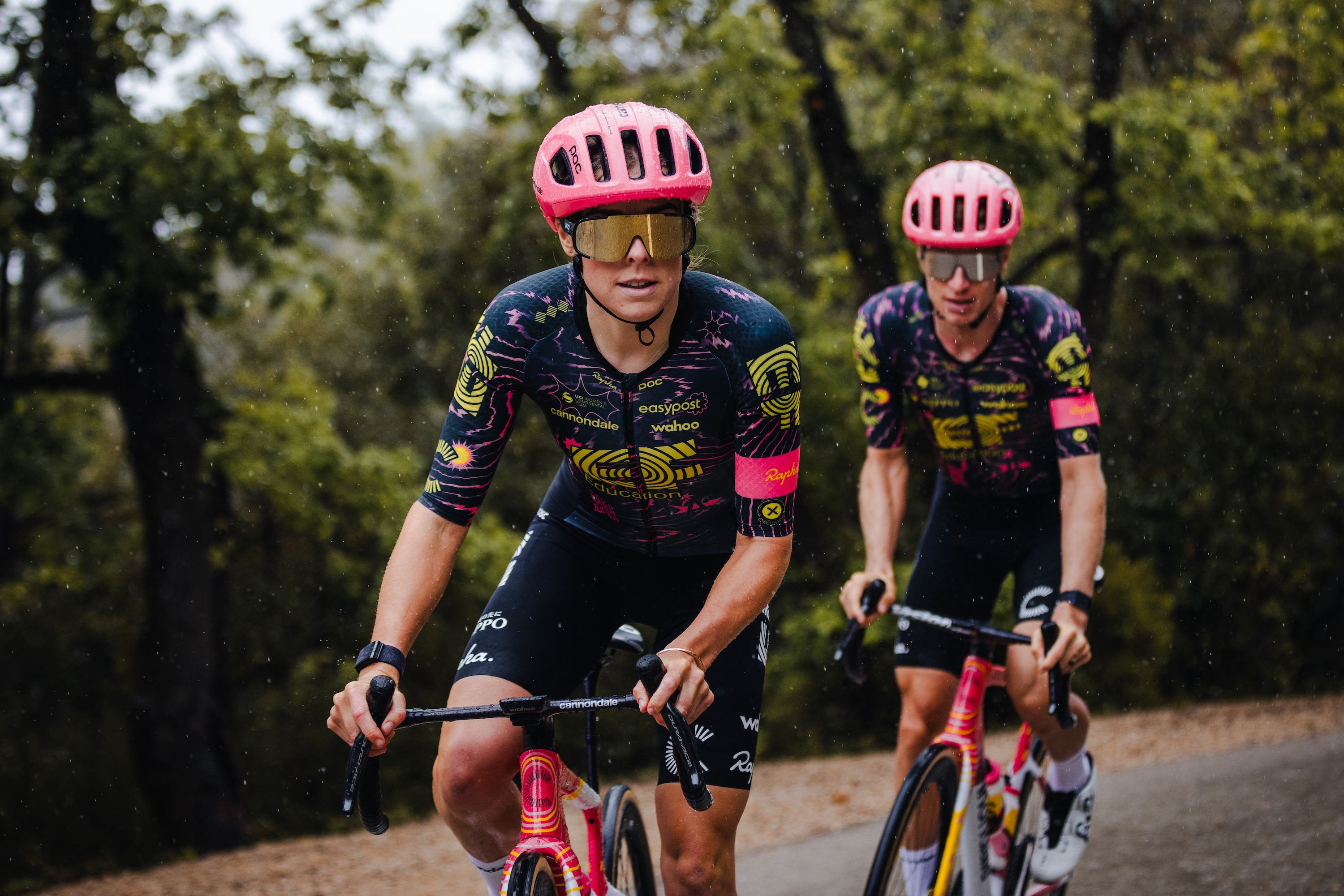 EF Pro Cycling and Rapha launch black Giro d'Italia switch out kit
EF Pro Cycling and Rapha launch black Giro d'Italia switch out kitThe American team have gone for black instead of their usual pink, in order not to clash with the maglia rosa
By Adam Becket Published

